PSWC magazine
Pastel Society of the West Coast
Pastel Society of the West Coast

MOOS 2024
See all the award winners and accepted entries in our Members Only Online Show.
Our Featured Artist
The incandescent Kim Lordier on art and life.
Art Ethics
Inspiration or Infringement? Laura Pollak on when the line is crossed.
Art School
Dug Waggoner on preparing your surface with texture.
Spring
Volume 16, Issue 1
2024
The Pastel Society of the West Coast joins the entire pastel community in celebrating the life and legacy of
Terry Ludwig




Artist Innovator Pioneer Pastelist. Your legacy lives in every studio.
2 www.pswc.ws
Terry Ludwig with wife Marie and painting en plein air
Terry Ludwig painting and with Vianna Szabo in class

ABOUT
Letter
Letter
PSWC Magazine | Spring 2024 3
Talk Art Bonnie Griffith talks to Lyn Diefenbach Art Ethics Laura Pollak tells a tale of stolen art - her own. Art School Dug Waggoner shares texture techniques
Workshop Workshop Coming 14 FEATURES
SUPPLEMENT MOOS 2024 Winners & Accepted Entries
Artist Kim Lordier talks to Pam Comfort Meet the Member Sabrina Hill introduces Tamsen Taves TABLE OF CONTENTS PSWC magazine 68 72 76
ART We
Art
SPECIAL
Featured
REGULARS
from the PSWC President From Pam Comfort
from the Editor From Sabrina Hill
Reps Update See whats happening in PSWC Pastel World
Housekeeping Here’s who’s new in the Society 8 4 10 16 62 50 82
Regional
PSWC

Dear Pastelists,
Welcome to another edition of the PSWC Magazine!
The MOOS show, chaired by Dug Waggoner, is gorgeous. We have some damn fine artists in this organization! Congratulations to all the winners and all the accepted entries. Sally Strand took on a real challenge choosing the accepted works and award winners. Thanks, Sally!
Pam Comfort’s interview with the lovely Kim Lordier is so delightful. Kim has made a name for herself as an artist and teacher, and you will get a glimpse into her life thanks to Pam.
Three weeks ago, I got to interview Tamsen Taves. This bright, confident artist made me laugh when she responded to the questions I ask all my interviewees, “What advice would you give to your 20-year-old self?” She answered, “Well, that was only two years ago, so I am not sure!” She is immensely talented, and I am certain you will be seeing her star rising in the art world.
Laura Pollak shared her encounter with an art thief in Art Ethics: Inspiration or Infringement? Imagine waking up to a Facebook post with near exact copy of your work credited to someone else? Read all about it on Page 68 .
In addition to managing the MOOS exhibition, Dug Waggoner found time to share one of his many techniques for creating award-winning work. Texturizing the substrate. See the step-by-step process in Art School.
Our We Talk Art series with Bonnie Griffith will feature Lyn Diefenbach. This is a wonderful opportunity to see Lyn talk about her art and art in general. Mark your calendar for April 21st.
A special thank you to Laura Pritchard who makes my job as editor easier with her skills in layout and perseverance. She is a huge asset to the production.
“Don’t think about making art, just get it done. Let everyone else decide if it’s good or bad, whether they love it or hate it. While they are deciding, make even more art.”
Andy Warhol
The magazine is a real love letter to the Society. From developing the stories, determining what our audience would like to read about, getting the interviews, writing articles, managing layouts, proof-reading (and NEVER finding all the mistakes until it goes to print!), double checking all the details, it goes on and on. This issue was no exception. The contributors have a genuine desire to present something that is great for the Society. We hope it shows.
Happy Painting,
Sabrina Hill
PSWC Vice President and Editor, PSWC Magazine
4 www.pswc.ws 4 www.pswc.ws
from the Editor
Letter
Contributors

Pam Comfort, President PSWC - In addition to serving as President, I chair the Scholarship Program, one of the ways we support students planning a career in art. My background is in the field of education. I earned a doctorate in Educational Leadership and Organizational Management, and retired from my position as Deputy Superintendent of Schools for Contra Costa County in 2018. Having only dabbled in art and music throughout my life, I discovered after retiring that I loved the immediacy and tactile satisfaction of working with pastels. love to travel and aspire to create art that communicates a strong sense of nature, culture and place. www.pamelacomfort.com

Laura Pollak PSWC, PSA, PSNC, SPS is a contributing writer for the Pastel Society of the West Coast publication. She is the past President of the Pastel Society of North Carolina, and the founder of Pastel Artists Teaching Internationally Online. She is exhibiting and showing galleries and museums across the country and has received many international awards. Her works have been featured in Strokes of Genius, The Pastel Journal, Pratique de Artes and PSWC Magazine. Laura teaches classes and workshops in her Studio in North Carolina and online via Zoom. She has achieved signature status in Pastel Society of America, Pastel Society of the West Coast, Pastel Society of North Carolina, Southeastern Pastel Society and Master Circle in the International Association of Pastel Societies.

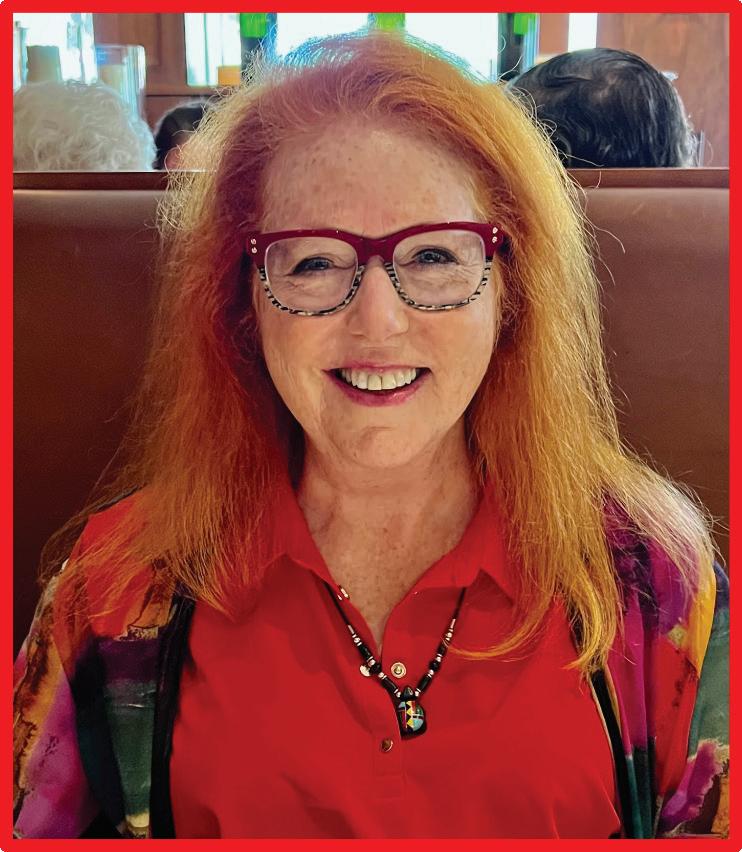
WANT TO GET INVOLVED?
There’s always room for more. Let us know what you want to do, and we’lll find a spot for you!
KEEP IN TOUCH & FOLLOW US!
Laura Pritchard - Graphics and Magazine Designer for PSWC Magazine -
Laura took a pastel workshop in 2021 from Kitty Wallis and fell in love with the vibrant color and direct application of a handheld pastel stick. Her subject matter is mainly landscapes and simple still lifes. She recently closed her freelance graphic design business and intends to put a lot more time into art making in 2024. https://www.laurapritchardfineart.com/
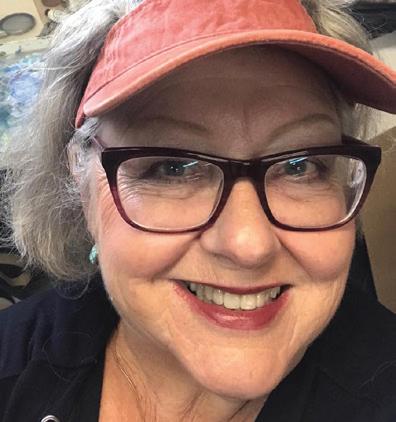
Bonnie Zahn Griffith PSWC, Secretary of the PSWC - is a current resident of southwestern Idaho and spends significant time in MT and UT painting throughout the year. She participates in numerous plein air events in the western US, judges competitions and offers workshops in pastel techniques, both studio and plein air. Her work is represented by galleries in MT, ID, OR and WA. Collectors include corporate and private throughout the US, Canada and Australia. Bonnie’s work can be seen on her website www.bonniegriffith.com
ABOUT THIS ISSUE
Cover art by Kim Lordier.
Fonts: Sabon and Open Sans
All photos are property of the artists
PSWC Magazine | Spring 2024 5
Contributors



You don’t have to live on the West Coast to become a member. With PSWC members located around the US, as well as international members, the Pastel Society of the West Coast offers a strong voice for expanding the presence of soft pastel as a major fine art painting medium.
PSWC was organized in 1984 to promote pastel artists and the medium of soft pastel. Today, we are one of the most recognized pastel societies in the country, with an ever-increasing international presence. Benefits include: Pastels USA Annual Exhibition | Members Only Online Competition | In-person and Virtual Workshops by Noted Pastel Artists | PSWC Magazine | PSWC Social Media Exposure Opportunities | We Talk Art Interview Series | Regional In-person Events | Online Demonstrations | Free Online Gallery | Membership in IAPS.
All levels of artists are welcome to join.
Our goal is to promote the art of pastels through education and competition and also to make it easier for you to become a well-connected, well-informed pastel artist. We look forward to including you on our Society’s roster!
6 www.pswc.ws
Join
PSWC
the most dynamic pastel group in the USA for less than 25c per day We. Are. Pastelists.
Magazine

(Remote) Desk of the President

Dear Members,
The year is off to a great start for your Pastel Society of the West Coast! Our annual Members Only Online Show (MOOS) was a another great success, with 227 artists entering 665 works this year. Our esteemed judge, Sally Strand had her work cut out for her! We think you’ll agree that she curated a beautiful show. Our thanks go to Sally and Dug Waggoner, our trusty show chair for all of the hard work they did to make this year’s show possible. Big congratulations to everyone who entered, those who had accepted works, and the extremely talented award-winners.
As we celebrate our member artists, and the joy of making art – we pause to pay tribute to a member of our pastel family who we recently lost. I never had the pleasure of meeting Terry Ludwig in person, but the many stories I’ve heard from friends and read online make it clear that he left a lasting impression on many, many people. We offer our sincere condolences to his family and friends. His legacy will live on in shared memories, and the art that his vision inspired.
When was the last time you visited the PSWC website? If it has been a while, you may want to peruse it for information about upcoming and ongoing events and programs. You will find: information about our We Talk Art series, along with links to videos of past interviews; information about our Quarterly General Membership Meetings, with links to videos of past demonstrations; information about upcoming daily painting challenges; information about our Scholarship Program; details about upcoming workshops and regional events; and of course, current and past shows and magazines.
Visit the website, join us on Facebook and let us know what you think. Thanks for being a part of the PSWC family!
Be inspired!
Pam Comfort
8 www.pswc.ws Desk of the President
Pam Comfort hiking Death Valley and working remotely for PSWC!
2024 Painting Challenges
CHALLENGE ONE: February 1st - 10th, 2024: Animal Instincts 10-day challenge #PSWC10N10- Create a portrait in a realistic or impressionist style of a pet or wildlife. Keep textures and personalities in mind as you create.
CHALLENGE TWO: April 1st – 10th, 2024: Complementary Colors 10-day challenge #PSWC10N10– Delve into the use of complementary colors to create an interesting work. Use complements to create contrasts when values are compressed, or add vibrancy and visual interest to a painting. Using complementary pairs like blue and orange, or red and green, in strategic areas of your artwork can make elements pop and draw the viewer’s attention.
CHALLENGE THREE: July 1st - 10th, 2024: Sunshine and Shadows 10-day challenge # #PSWC10N10- Summers days are filled with contrasts of bright sunshine and deep shadows, or dappled sunlight through the trees. Capture a bit of summer in this challenge.
CHALLENGE FOUR: October 1st - 21st, 2024: The Big Challenge, 21 paintings in 21 days #PSWC21N21–. Great way to get some holiday gifts done or ready to sell. You may even create the painting you enter in MOOS in 2025! Here are the rules:
Members Only
Any subject
Any size – though we recommend 6”x6” to 9”x12” for the sake of speed
Mostly pastels
Must post every day to be entered into prize-drawing
Quick studies are OK
New work only
Posting Rules:
• Please post on our PSWC Facebook Page with a commentary about the painting (a paragraph is plenty)
• Include Hashtag at end of post #PSWC10in10 or #PSWC21in21
• You may comment on other artists’ paintings, but this is not a critique. No negative comments.
Suggestions for process:
• Limit painting time- We suggest 30-45 minutes.
• Limit palette- Try a limited palette. Experiment with temperature and hue
• Try different pastels- Work with hard instead of soft or soft pastels instead of hard. Try pastel pencils.
• Change subject matter- If you paint plein air, try a still life or a portrait. Try Abstract.
• Experiment with underpainting- Try a wet underpainting with water or denatured alcohol. One artist in our society underpaints with splashes of ink.
FEBRUARY 2024
Challenge One - Samples



PSWC Magazine | Spring 2024 9 Painting Challenges
Cat by Jacklyn Amerman
Fish by Janis Chittick
Gorilla by Olga Sima
Regional Reps Rockin’ Pastels!
On the move, easels in hand, creating art where ever they can.

San Francisco Bay Area Peninsula to Big Sur
Here are pictures from the San Francisco peninsula paint-out organized by Jan Prisco in November, 2023. There were five painters at Rockaway Beach in Pacifica, California! Jan is the Regional Representative for the San Francisco Bay Area Peninsula to Big Sur region.
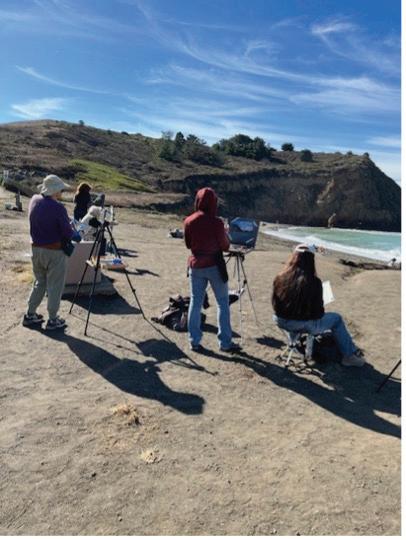

California Central Coast/San Luis Obispo County
Bobbye West-Thompson reports the following events on the agenda for the California Central Coast/San Luis Obispo County region: In April, we’ll visit Montana d’Oro State Park and paint from above Spooner’s Cove, with unlimited ocean views, rock outcroppings and shoreline vegetation. In June, we’ll be painting Hollister Peak, one the county’s iconic rock formations viewed from Hwy 101. In September, although I haven’t touched base with the new Santa Barbara rep, I’m hoping to plan a joint-venture with her in Los Alamos (a charming little “village” 40 miles south of San Luis Obispo, with great painting opportunities and wonderful restaurants).

10 www.pswc.ws
Regional Reps Update
Spooner’s Cove
Idaho/Montana/Wyoming
Winter 2023/2024: On behalf of our Idaho/Montana/Wyoming region, representative Cindy Gillett, sends the this update- The Impressionists Immersive opened in Boise, Idaho at the Discovery Center during the fall of 2023. This immersive arrived in Boise from Spain. Throughout the fall and winter months, many of our PSWC members attended the exhibition to marvel at the floor to ceiling display of over 1,000 masterworks by artists such as Monet, Van Gogh, Renoir, and more. Each artist found the synchronized projection, music and audio narrative simply captivating.




Impressionists Immersive

PSWC Magazine | Spring 2024 11
Regional Reps Update
Idaho/Montana/Wyoming (Cont’d)

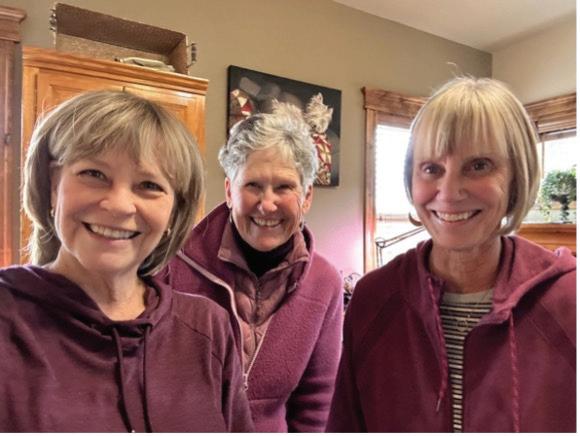
January 2024 Open Studio: During the month of January many of our members participate in one art challenge or another (Extreme Plein Air and the Strada Easel Challenge to name a couple). Regional Representative Cindy Gillett opened her studio in Meridian, Idaho each Saturday in January to encourage other PSWC members to come and visit with no real agenda in mind other than to talk shop, share tips, watch a demo, share excess supplies, and of course, paint! Not one to tackle plein air painting during the winter months in Idaho, Cindy said it ended up being a really fun month! Especially because each weekend was different, never really knowing who would come knocking on her door. Open Studio 2024



12 www.pswc.ws
Regional Reps Update
with Cindy Gillett
Tina Canova and friend
Cindy Gillett, Bonnie Kenaley, and Norma Miller
Bonnie Kenaley and Norma Miller
Left and above: On the easel at the Open Studio
...and in other corners of Pastel World...



PSWC Magazine | Spring 2024 13 Regional Reps Update
Dug Waggoner at the easel in his studio in El Cerrito, California
Erika Perloff painting a beaver dam in Lundy Canyon
Photo by Paul Keel
Vikki Brink on the Oregon coast, “I was in hog heaven despite the fact I looked like the hunchback of Notre Dame!”

We Talk Art is the new quarterly Zoom presentation for members of the PSWC. Bonnie Zahn Griffith chats with well known artists in an informal virtual setting.

April 21, 2024, 12:00
Noon – Featuring Lyn Diefenbach
The pursuit of masterly quality and technique is a high priority for Lyn Diefenbach whose work is imbued with a celebration of her faith and of life. Her paintings in pastel and oil cover a myriad of subject matter with her bold florals consistently receiving accolades nationally and internationally. Her ability to communicate her ideas has entrenched her as a respected and sought-after
tutor, with teaching engagements internationally and across Australia.
Lyn was accepted into the International Guild of Realism in 2008, and holds Master Pastelist status with the Pastel Society of Australia. Lyn was awarded Eminent Pastelist status in the International Association of Pastel Societies in 2019, having achieved master Circle status with that group in 2014. Lyn was accepted into the Pastel Society of America as a Signature Member in 2016. She has been featured numerous times in the International Artist, Pastel Journal,Pratique des Arts and Australian Artist magazines.
Info about Lyn from her website.

14 www.pswc.ws
Bonnie Griffith
We Talk Art
Reflecting History by Lyn Diefenbach


The Art of Lyn Diefenbach

PSWC Magazine | Spring 2024 15
Artist Lyn Diefenbach
Phoenix by Natasha Isenhour
Iridescence by Lyn Diefenbach
We Talk Art
The Light Revealed by Lyn Diefenbach


A Special Supplement MOOS Members Only Online Show 2024


18 www.pswc.ws MOOS Members Only Online Show 2024 MOOS 2024 Winners Signature/DP | Best In Show The Milano Boot by Otto Stürcke
The Pastel Society of the West Coast’s Members Only Online Show represents some of the best art in pastels. Thank you to all those members who entered the MOOS 2024. We are so grateful for our judge, Sally Strand and to our show chairman, Dug Waggoner for all the hard work they put into this event. Special thanks to Austin Hamby at ShowSubmit.com for his tireless work getting everything ready for judging! Here are all the accepted entries and prize winners. Thank you for making this such a dynamic, beautiful show.
General Membership | Best In Show
My Kitchen Window Sill by Francis Huffman


PSWC Magazine | Spring 2024 19 MOOS Members Only Online Show 2024
Signature/DP
First Place
San Juan
by Stan Bloomfield
MOOS First Place Winners


General Member
First Place
Hey, Sunshine
by Deborah Dickson Shea
20 www.pswc.ws
MOOS Members Only Online Show 2024
MOOS Second Place Winners

Signature/DP
Second Place
Fresh Snow
by Tony Allain
General Member
Second Place
Flying Home
by Jim Kallenbach

PSWC Magazine | Spring 2024 21 MOOS Members Only Online Show 2024
MOOS Third Place Winners

Signature/DP
Third Place Eons
by Renee Marz Mullins
General Member
Third Place
Goldenrod, Golden Hour
by Stephanie Jean Brown

22 www.pswc.ws
MOOS Members Only Online Show 2024
MOOS Honorable Mentions
Signature/DP
Honorable Mention
Coping
by Judith Kazdym Leeds


General Member
Honorable Mention
Little Dippers
by Glen Maxion
PSWC Magazine | Spring 2024 23 MOOS Members Only Online Show 2024
ACCEPTED ENTRIES - SIGNATURE/DP
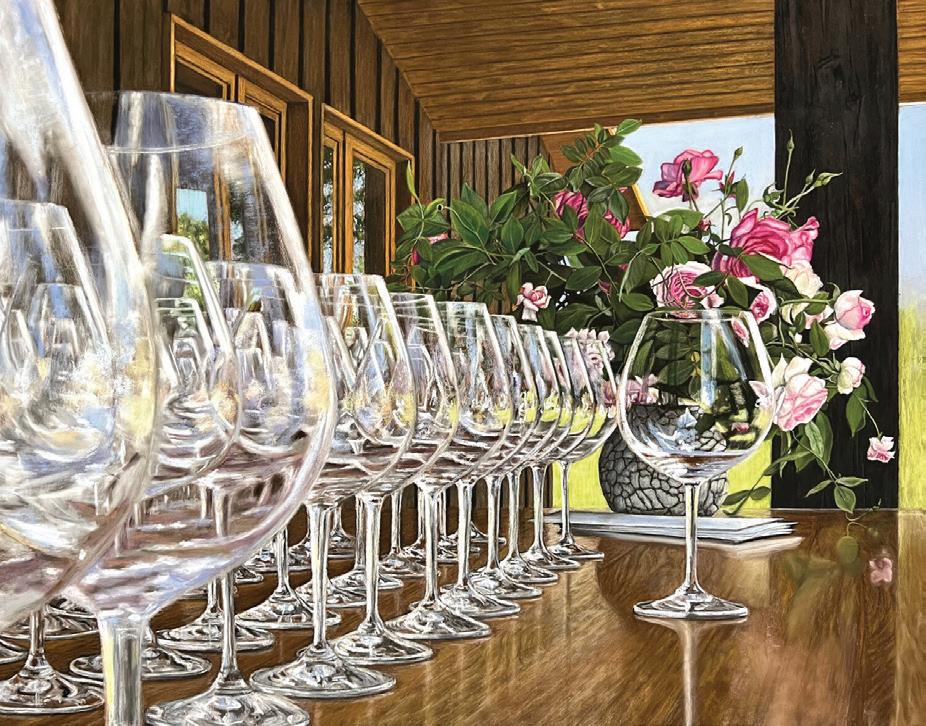





24 www.pswc.ws
Pick Up Party by Bithia Bjurman
The Flame by Patti Arbino
Meadows Beach by Jennifer Blackburn
Captain Chris by Diane Sauble Breuer
Poppy Bloom Buellton Botanical Gardens by Deborah Breedon
Wall Dogs in China Town by Gerald Boyd
MOOS Members Only Online Show 2024






PSWC Magazine | Spring 2024 25
In The Flow by
Sunset Colors at Crescent Beach by Donna Catotti
Janis Lacy Ellison
A Stitch In Time by Cindy S. Gillett
Sunset Dune by Terry Ford
MOOS Members Only Online Show 2024
Guardian Of Souls by Diane Fechenbach
Malibu Creek by Esther Engelman




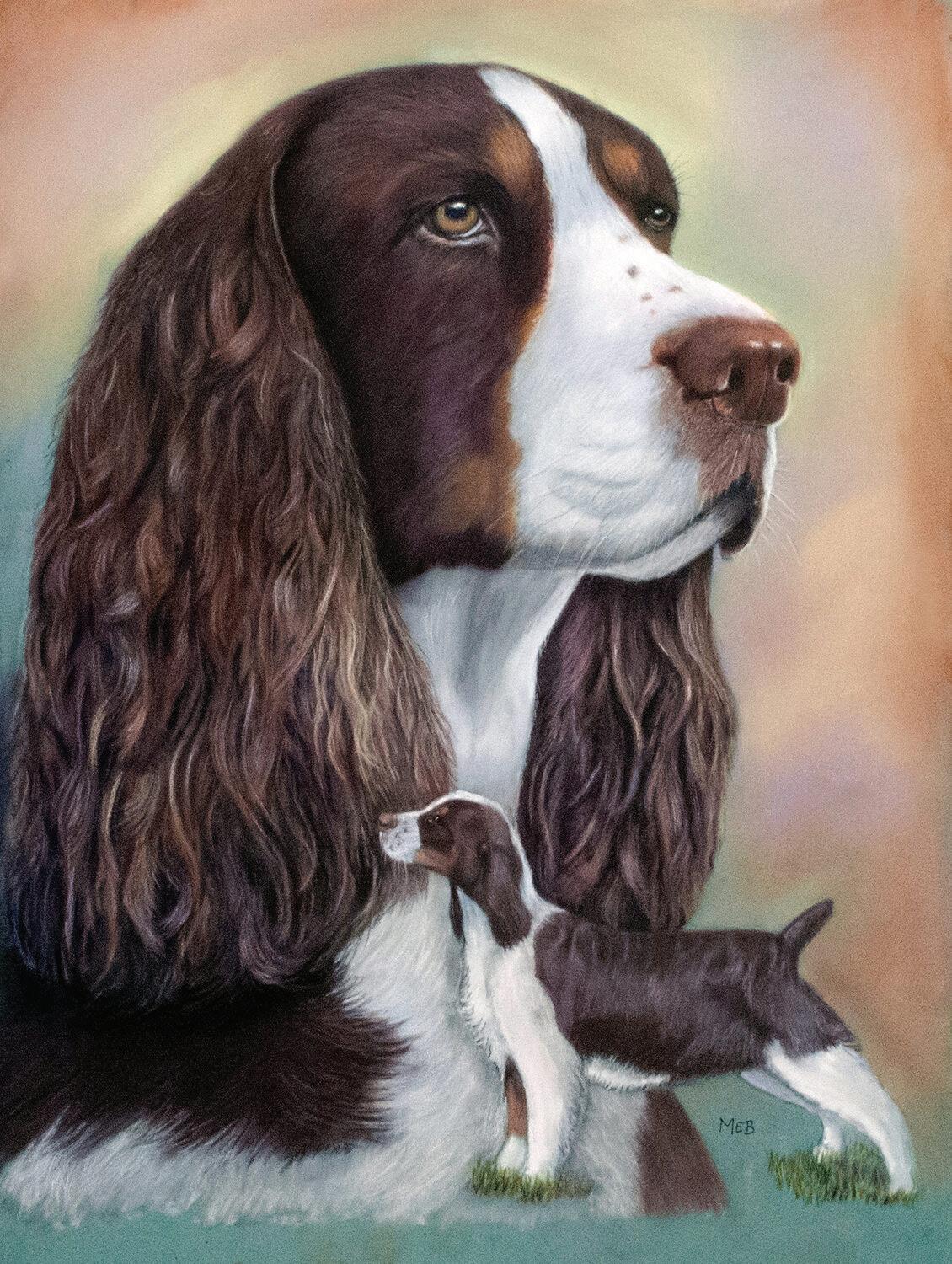

26 www.pswc.ws
Last Light by Bonnie Zahn Griffith
Amber Day by Morgan Green
Double Yellow Line by Ellen Gust
Calypso by Marianne Harris
Golden Hour by Deborah Henderson
MOOS Members Only Online Show 2024
Above the Trail by Dotty Hawthorne






PSWC Magazine | Spring 2024 27
Summer Lovers by Karen Israel
Radiant Heart by Katherine Irish
Shadow Play by Karen Horne
Ranch Memories- Winter Road by Becky Johnson
MOOS Members Only Online Show 2024
Wapama Falls by Virginia Kamhi
Open Country Wild by Randye Dale Jensen






28 www.pswc.ws
For Me It’s Always Spring by Shuk Susan Lee
Catching A Dream 3 by Tai Meng Lim
Raw Meat by Yael Maimon
Early Snow #3 by Kathleen McDonnell
Street Corner by Andrew McDermott
MOOS Members Only Online Show 2024
Wildflower Bouquet by Susan Kuznitsky


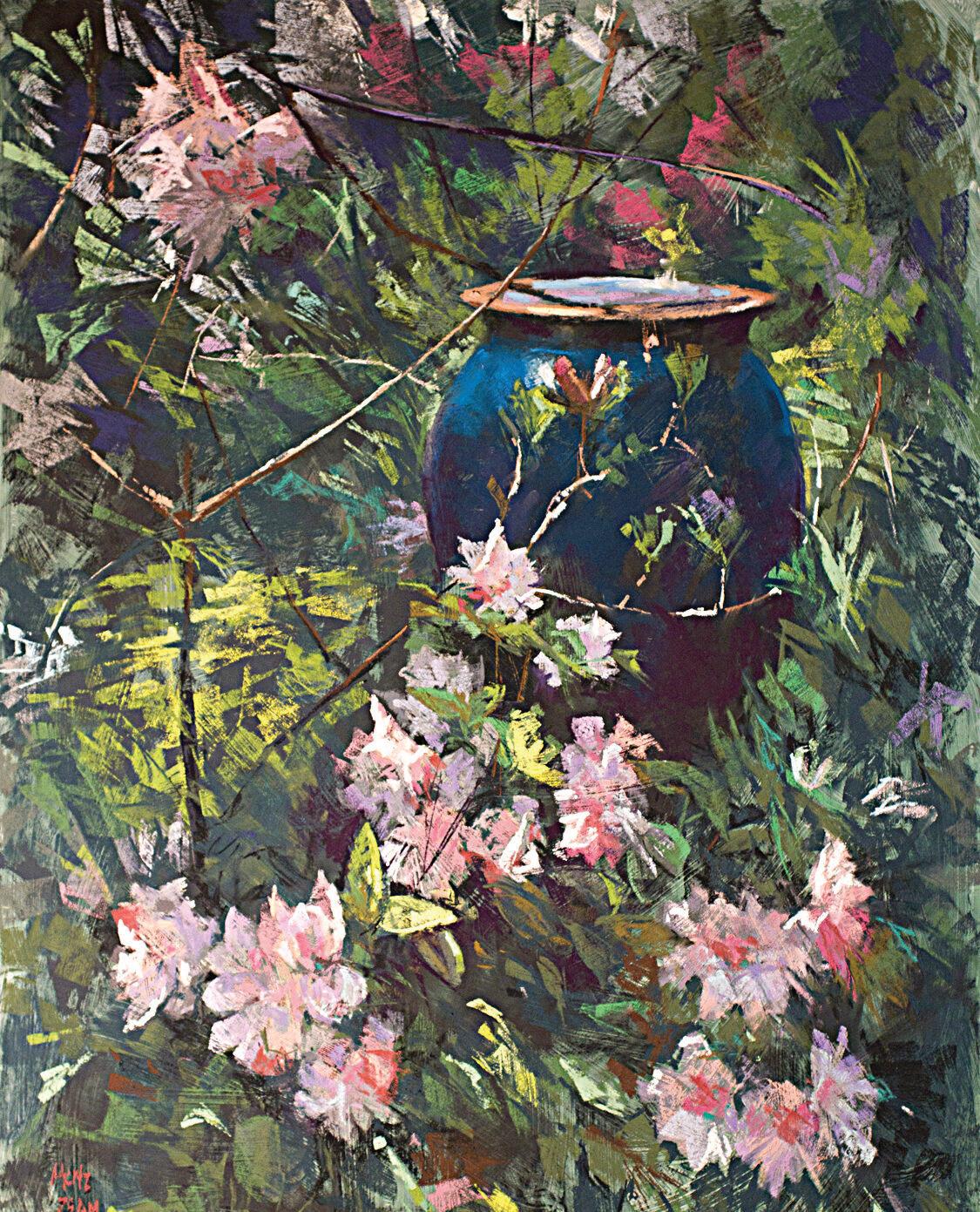


PSWC Magazine | Spring 2024 29
Sanctuary by Eveline Miller
Grape Trellis by Karen A. Miller
Gossamer Wings by Jan Y. Miller
MOOS Members Only Online Show 2024
Montana De Oro Beach by Clark Mitchell
Jim Scott’s Garden by Nancie King Mertz
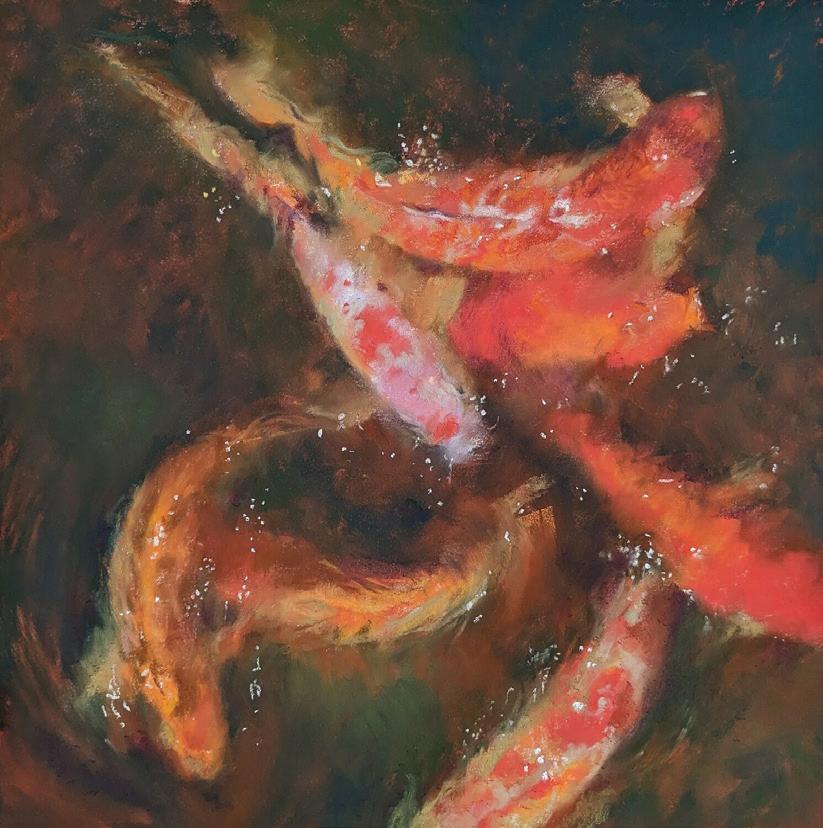





30 www.pswc.ws
The Dance by Maryann Mullett
Evening Bliss by Linda Louis Mutti
Lowland by Barbara Bernadetti Newton
Girl by Christine Obers
El Burro Loco by Jean Myers
MOOS Members Only Online Show 2024
A Great Day Painting by Barbara Noonan

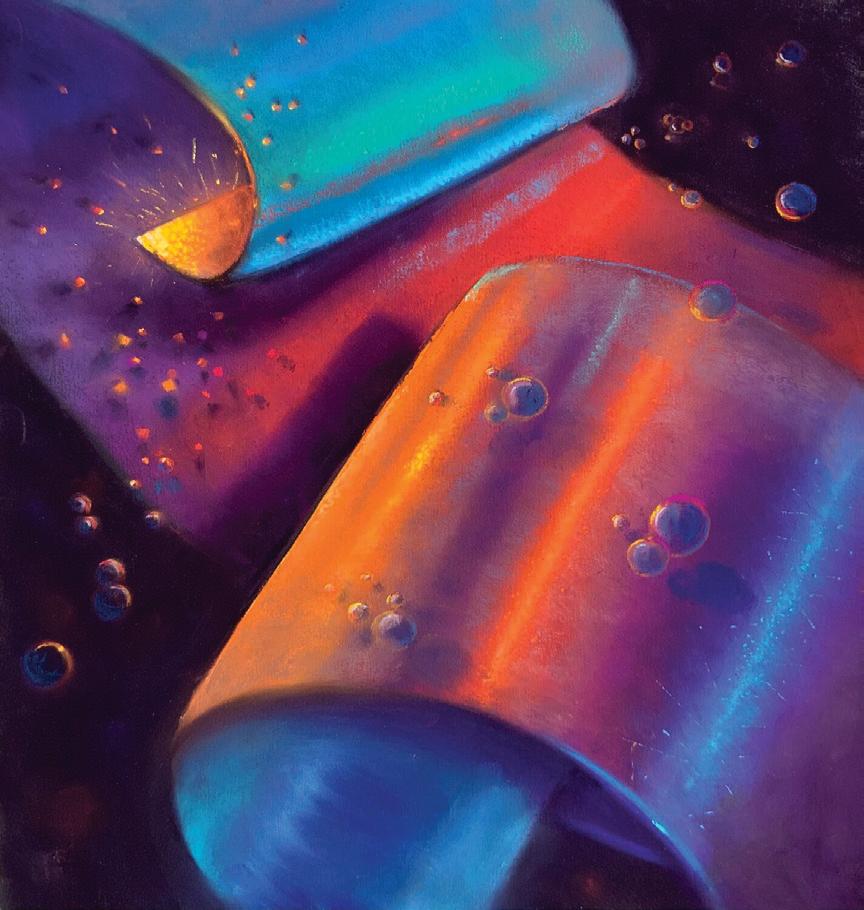




PSWC Magazine | Spring 2024 31
Under the Bridge by Janet L. Patterson
Hazy Shade of Winter by Deborah G. Pepin
Outside The Boundaries by Laura E. Pollak
MOOS Members Only Online Show 2024
Ripple by Peggy Davidson Post
Distant Thunder by Fran Odum
Call Of The Wild by Heidi Reeves






32 www.pswc.ws
Autumn Field by Barbara Reich
City Side Street by Tamra Sanchez
Back In The Day by LaVone Sterling
Morning Peace by Ann Sanders
Paddle Board Moonrise by Vianna Szabo
MOOS Members Only Online Show 2024
No More War by William Schneider






PSWC Magazine | Spring 2024 33
MOOS Members Only Online Show 2024
View Through the Cedars by Helen Turner
De Colores by Nori M. Thorne
Hemlock by Carol Talley
Rabbit Brush by Terri Taber
Last Light by Donna Theresa
Sun-Kissed by Marie Tippets





34 www.pswc.ws
Three Blackbirds by Dug Waggoner
Marsh In Bloom by Sharon Will
A Sharp Eye On The Orchard (Sharp-shinned Hawk) by Kimberly Wurster
MOOS Members Only Online Show 2024
Clarity by Daggi Wallace
Waiting, Watching by Jim Tyler
ACCEPTED ENTRIES GENERAL MEMBERSHIP

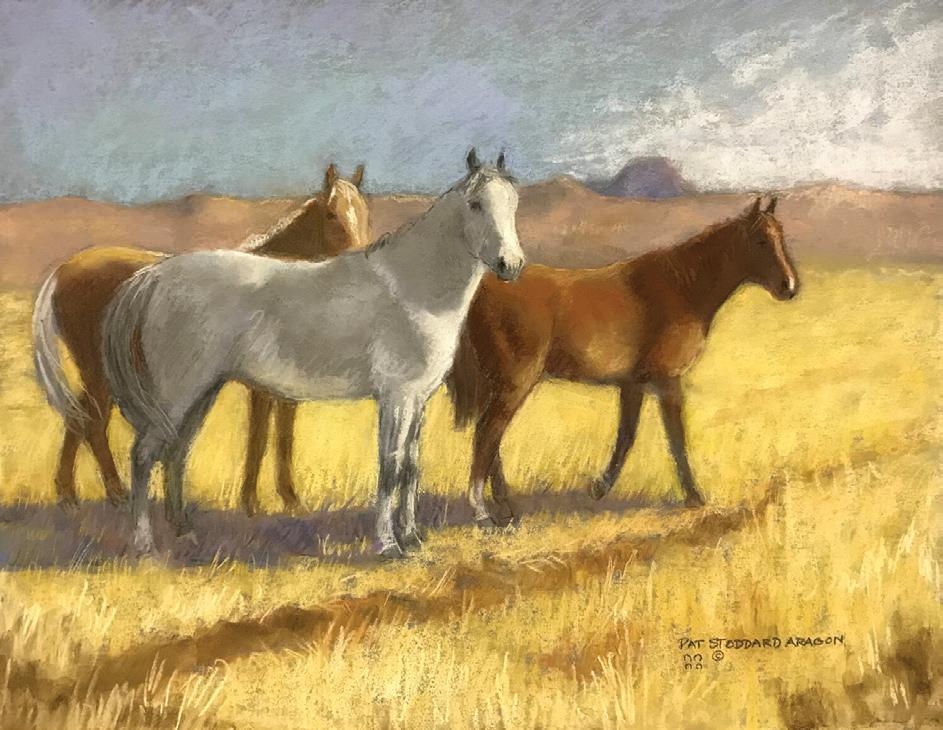



PSWC Magazine | Spring 2024 35
MOOS Members Only Online Show 2024
Limelight by Laure Ann Basham
Autumn on Tin Cup Creek by Marcia A. Ballowe
Gecko Smiles by Lynn Folse Attig
Painted Lady by David Baker
Horses By the Butte by Pat Stoddard Aragon






36 www.pswc.ws
Yellow Peonies by Virginia A Bittler
Daylily by Johanne Boisvert
Reflexions by Jose F. Caro
The View by Suzanne Burnell
Midsummer Glory by Gina Carstens
MOOS Members Only Online Show 2024
Queen Lily by Laetitia Comps-Agrar






PSWC Magazine | Spring 2024 37
Diversity by Marie-Pierre Chevalier
Pretty Boy! by Margaret Casner
Amber Stare by Lauren Chan
Inspirado Otra Vez by Becky J. Chappell
Potter’s Table by Brigette Comellas
MOOS Members Only Online Show 2024
Coos Bay Sunday by Pamela Comfort






38 www.pswc.ws
With the Angels by Sidnee Cox
Wizard In Training by Molly Ann Cooley
Mirrors Of The Soul by Elizabeth DeMaria
Among The Trees by Pamela A. Fox
MOOS Members Only Online Show 2024
Whatnot Security by Donna A. Dutra
Talkin’bout Boats and Things by Jay DeChesere

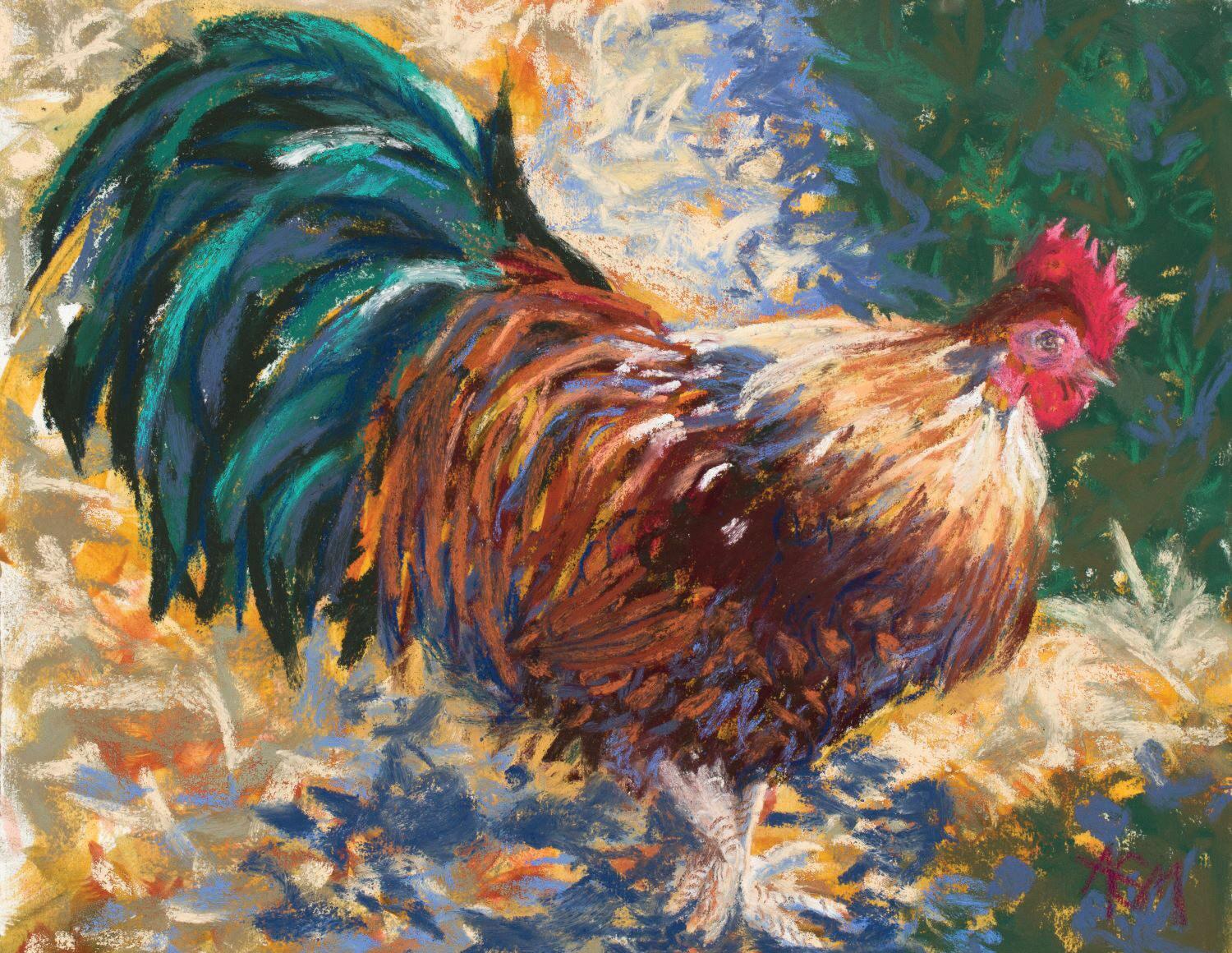




PSWC Magazine | Spring 2024 39 MOOS Members Only Online Show 2024
Untethered by Mardilan Georgio
Deep Within by Ronnie Gold
Lost In The World Of Dreams by Masoud Habibyan
After the Storm by Kelly Ann Hine
Roo by Amy Glover Martin
Little Big Eyes by Mary Hopkins

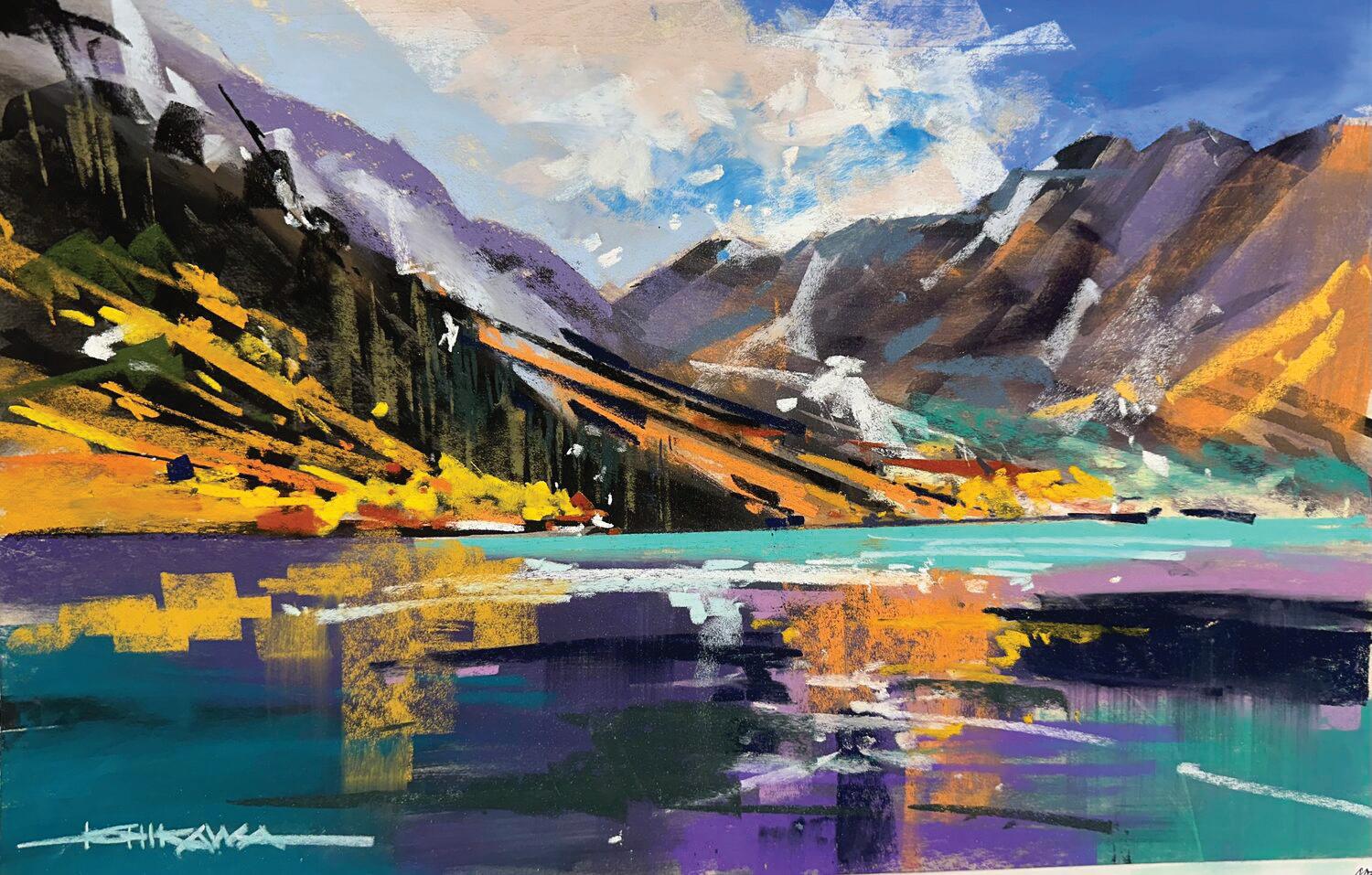




40 www.pswc.ws
Convict Lake Autumn by Mike Ishikawa
Incoming by Lily Hurlimann
Emily by Tricia Kaman
Glory In The Sky by Karen L. Jones
Descent by Lynn Kearny
MOOS Members Only Online Show 2024
Big Sisters Are So Smart by Ken L. Keith




PSWC Magazine | Spring 2024 41
Memories For Sale by Denice Peters
Futility Of Fences by Margaret Larlham
MOOS Members Only Online Show 2024
Last Glow by Patricia Pendergast
Bamboo Reflections by Carmen Lamp
Andres by Alane Levinsohn
Prelude To Roses by Lynda Kravitz

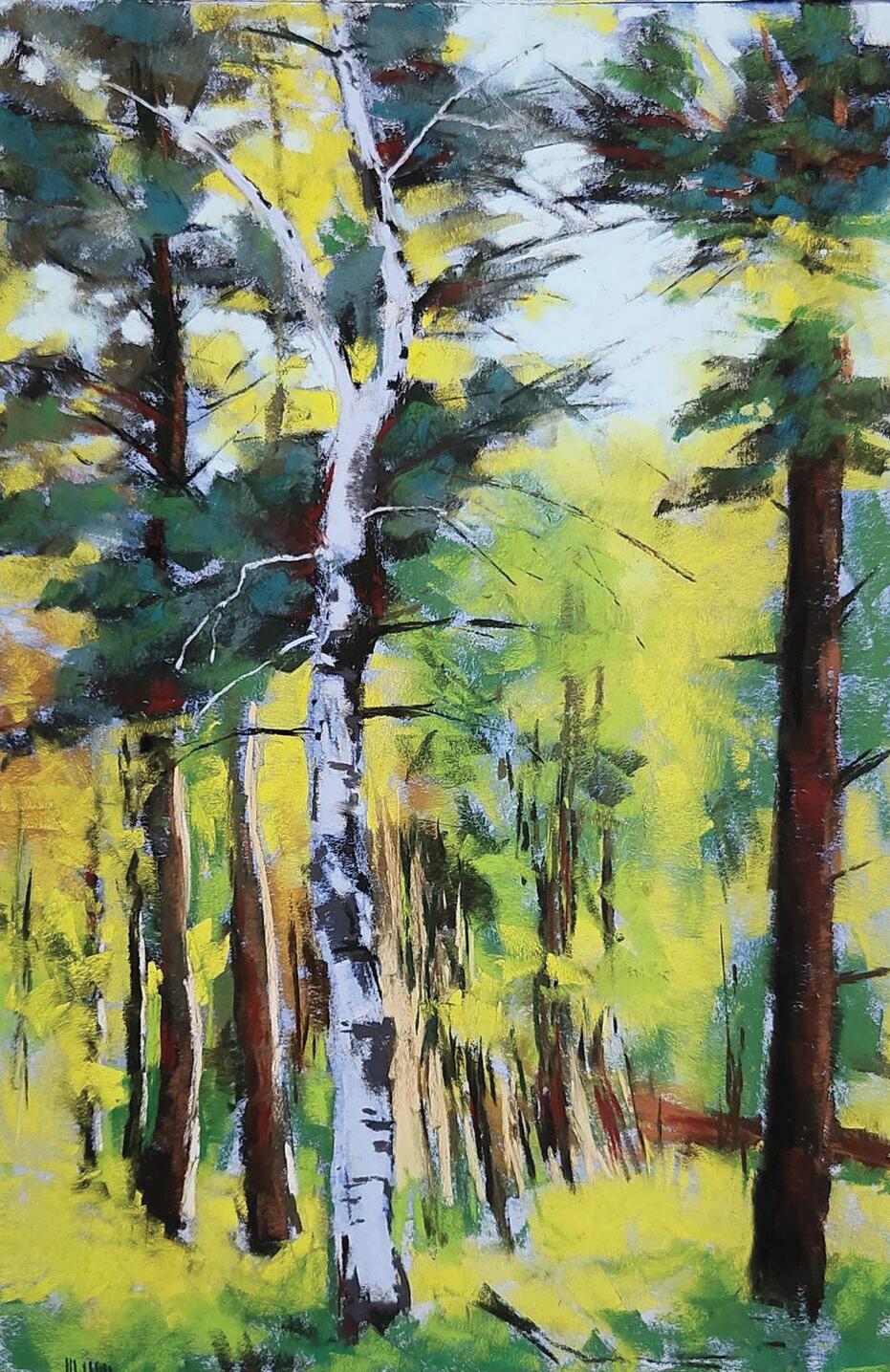



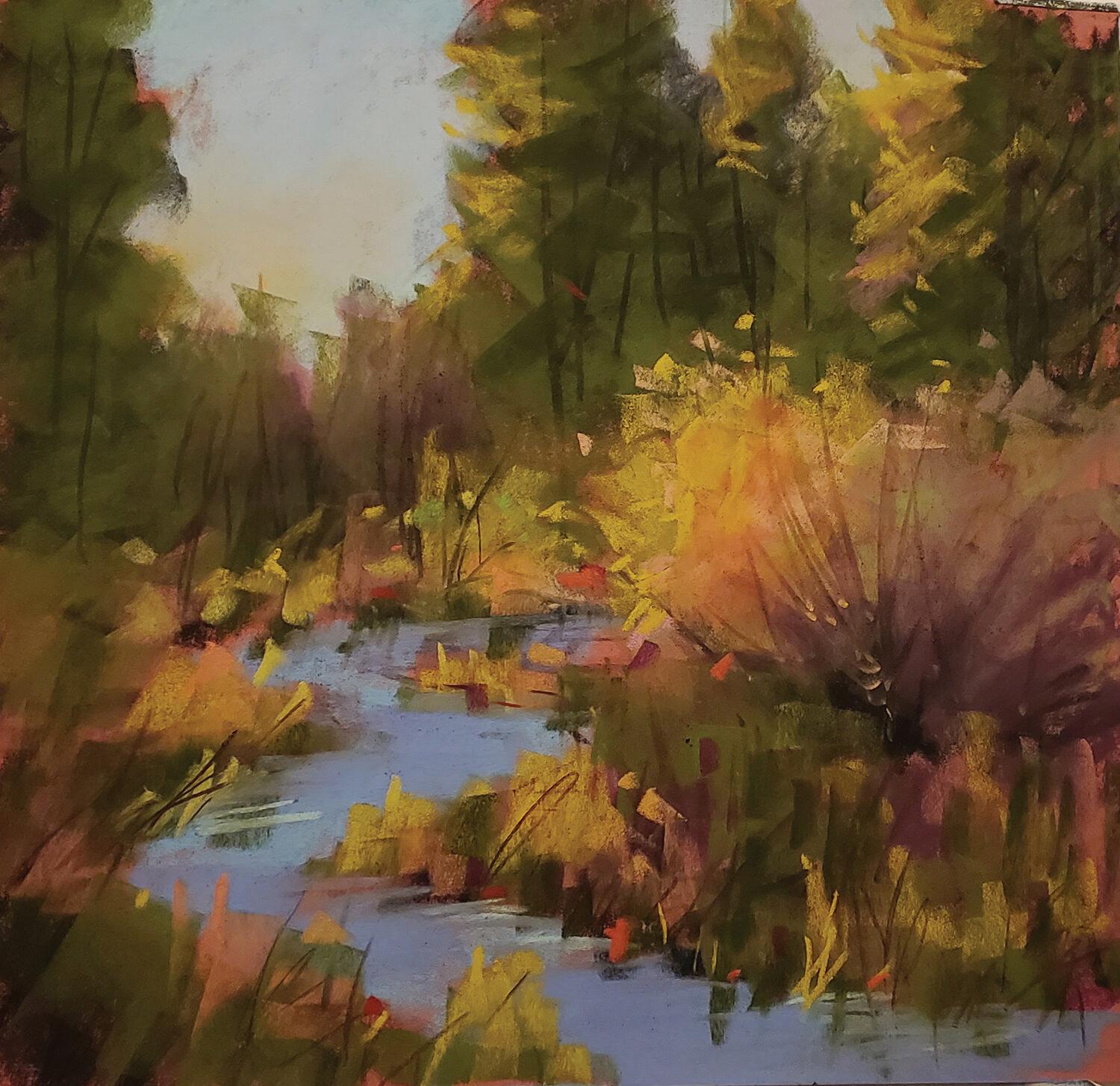
42 www.pswc.ws
Tea In The Afternoon by Nancy C. Lilly
Bow Lake by Sharon Faer Lichtenstein
Le Fils a Son Pere by Melissa Losano
Birch Amid Pines by Mary J. McInnis
The Magic of Color by Nancy Lee Misek
MOOS Members Only Online Show 2024
Lost and Found by Ugo Paradiso





PSWC Magazine | Spring 2024 43
Al Fresco In Redondo by Natalie Richards
Drive Into Summer by Janet M. Rawlings
MOOS Members Only Online Show 2024
Early Morning Light by Linda Richichi
No One Wants to Play by Denice Peters
Rising by Tony Reid




44 www.pswc.ws
Reaching By Denise Rizzo
Quiet Nights by Letitia Roller
Wishing You Were Here by Lorraine Roberts
MOOS Members Only Online Show 2024
Palomino Glow by Sarah Rose





PSWC Magazine | Spring 2024 45
Willow Wanderings by Darcie Roberts
Chrome Relic by John Sherry
Rice Harvest by Anne K. Spivey
Hatch At Chipmunk Rapids by Kelly Rudolph
MOOS Members Only Online Show 2024
Torrey Pines Hike by Robin Samiljan




46 www.pswc.ws
Descent by Kahne D. Smith
Afternoon Shadows, La Quinta Cove by David Wolfram
Taking the Plunge by Jill Storey
MOOS Members Only Online Show 2024
Downpour by Carol Strock Wasson




PSWC Magazine | Spring 2024 47
Winter’s Gift by Jill Stefani Wagner
Rowena Rampart by Harley Talkington
Pops And Ram Ram by Caryn Marie Stromberg
MOOS Members Only Online Show 2024
Spring by Marsha Tidy
JUDGE AND JUROR MEET SUSAN KUZNITSKY




48 www.pswc.ws
Puya Group by Elizabeth White
Soar by Christina Williams
Autumn Gold by Marianne J. Woosley
MOOS Members Only Online Show 2024
Autumn Path by Kathryn Young
Judge and Juror: Sally Strand
“I relate to small moments of life that are often overlooked. These moments resonate with me because they are familiar — we see ourselves in them. They sometimes suggest things beyond the obvious. Painting mundane objects or tasks provides me with a challenge to portray the commonplace in a compelling way, to make the usual unusual and worthy of notice.
My current body of work, painted with oil and pastels on canvas and paper, depicts moments in everyday life as experienced by the people most significant to me. My paintings have subtle, suggestive narratives: singular moments of life in the world, slices of daily life, the implied passage of time. They bring together my interests in abstract shapes and formal space combined with naturalistic figures and the many nuances of light. Through the familiar and commonplace content of these paintings, I attempt to explore emotion and mood as a form of visual poetry.”
ABOUT SALLY STRAND
A native of Colorado now residing in California, Strand has been exhibiting professionally as an artist for close to 40 years. Strand was inducted into the Hall of Fame, the highest commendation of the Pastel Society of America, New York. She was honored with the Eminent Pastelist Award and designation, the highest commendation of the International Association of Pastel Societies.
She is the recipient of numerous top awards, including the PSA Master Pastelist distinction and
the IAPS Master Circle Medal. Her solo exhibitions in galleries and museums include a one-person retrospective of pastel and oil paintings at the Bakersfield Museum of Art in California.
Widely

published in books and magazines internationally, her work is also represented in many private, corporate and museum collections including the Butler Institute of American Art. Strand studied at the American Academy of Art in Chicago, the Art Students League and National Academy of Design in New York. She holds a BFA degree from the University of Denver and an MFA from Laguna College of Art and Design. Strand teaches workshops and master classes internationally..(from her website)
www.sallystrand.com
PSWC Magazine | Spring 2024 49
MOOS Members Only Online Show 2024
 Big Sur Glory by Kim Lordier
Big Sur Glory by Kim Lordier

Kim Lordier
POOF! Kim Lordier Breathes Life Into Her Work
I first had the privilege of meeting Kim Lordier on the front steps of the Haggin Museum where I was about to pass out the awards for the PSWC’s 2023 Pastels USA: 99 Voices in Pastel exhibition. I know I was looking a bit stressed due to a little glitch in plans, and she asked if she could help in any way. That’s Kim in a nutshell. Kind, generous and thoughtful. When I stepped into the gallery and stood in front of her incredible work, Baby, It’s Cold (First Place, Contemporary Impressionism), I was so stunned by it that I knew I would have to find an opportunity someday, somehow to ask her about it. I had my opportunity during a candid video call in mid-February, for which neither of us wore makeup.
Pam: We’ve read in your biography that you majored in art illustration in college, but worked as a flight attendant and were also a horsewoman. Did you do any work as an illustrator?
Kim: The short answer is no. I worked ever so briefly designing a wallpaper, based on somebody else’s ideas through an interior design firm. That went nowhere. In college, I had no self-confidence, no burning passion, no inner drive. In hindsight, I probably belonged in the fine art department, but I was blessed with parents who helped to support me in college, and I agreed to study something that might entail an actual job after, thus commercial illustration. So, I became a flight attendant, since my father, who is a retired airline captain, came home with two applications, flight attendant or customer service and said, “Pick one.” I was still living in their home. With that said, I was painting and selling animal portraits, mostly horses and dogs, since I was 15 years old. So, I continued painting them while flying and competing with the horses around the western United States. Towards the late 1990’s I started to dabble in landscapes from photos and painting the figure/portrait with Bob Gerbracht at his studio in San Francisco. It wasn’t until I started painting the landscape from life that I found my passion, my voice.
PSWC Magazine | Spring 2024 51
Kim Lordier talks to Pam Comfort
Rights
Images
by Kim Lordier © All
Reserved
Our Featured Artist: Kim Lordier

Pam: How did the events of 9/11 impact your decision to commit to creating art full time, and do you think that those events also had an impact on your art itself?
Kim: I’m not sure 9/11 influenced my actual work, as I was still finding my creative voice at the time. However, the airlines offered a volunteer furlough, and I took them up on it. It was one of those times when you realize that life is short, and you’ve got to go after what you want. The furlough provided an opportunity for me to pursue my dream, with a huge safety net in case painting full-time didn’t work out. Although, even at that time I didn’t realize that it was a dream of mine. It was just a very fluid thing. At about the same time, I saw my first Early California Impressionist exhibition at the Oakland Museum of Art, and it was the first time I felt like I was gut punched. I had to sit down and catch my breath. Edgar Payne’s Autumn Sycamore blew me away as did much of the show. I also saw a plein air demonstration around that time and knew that was
what I was meant to do. Sounds silly, but true.
Pam: Tell me more about this “gut punch” you felt.
Kim: As a flight attendant, I traveled around everywhere, and I was able to go to the Met, to the Louvre, and to the Boston Museum of Fine Arts - but I had really never experienced the early California Impressionists. I had seen work by the French impressionists in the Musée de l’Orangerie in Paris, and I walked through those galleries and was amazed by the beautiful work. But it really wasn’t until I saw this Early California Impressionist exhibition sponsored by The Nature Conservancy showcasing California and its various habitats, featuring painters from the mid-1800s through the 1920s and 30s, that for the first time I really felt like I found a place for my voice.
I can’t even explain it. I had to sit down and just take it all in because for me, it was this amazing marriage of that broken color that the French impressionists
52 www.pswc.ws
Our Featured Artist: Kim Lordier
Baby, It’s Cold by Kim Lordier
were doing and this super strong tonal design behind what the California impressionists were doing.
In large part, I think it’s also about our state, and the beauty of our state, and the different microclimates that we have here. These are reflected by the tonal quality in the work of the artists from Northern California, and then we have the Southern California artists depicting the more Mediterranean light, and then right in the middle is the Monterey peninsula and all that, which gets a little bit of both. We have such a wide variety: canyons, coastlines, deserts, forests, and mountains. Many of these early California impressionists, like Guy Rose, went to Paris to study and when they came back here their work got married with the tonalism that was happening here. So, there was this strong backbone of design and value, with broken color and beautiful
light. That is what struck me.
I also had just watched a woman give a demonstration at a local art club in plein air. When I was in school, I went out a couple of times with one of the classes, but for my first plein air experience ever, they took us to the Palace of Fine Arts in San Francisco! Yeah, draw the Corinthian columns, and the dome, and the water pond, and the ducks, and the fountains - I was completely out of my element. So, seeing that work of the California Impressionists was very powerful for me and still is to this day. When I’m painting and struggling with a problem, for example, I’ll go see how William Ritschel solves the glistening water on top of the sea.
Anyway, this all lit a fire in my belly. For the first time I was confident that I had a creative voice. It was
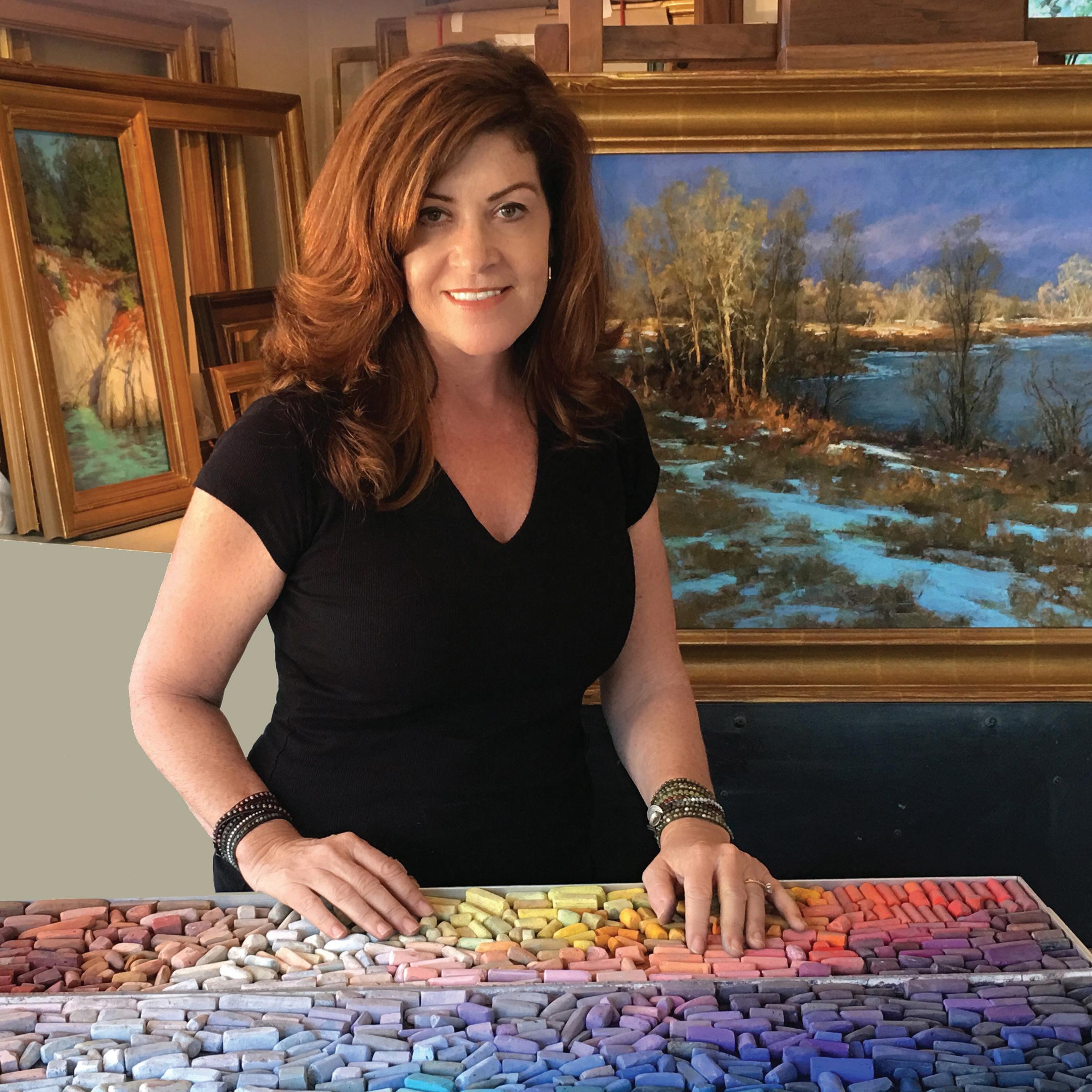
PSWC Magazine | Spring 2024 53
Our Featured Artist: Kim Lordier
Kim Lordier in her studio

huge, huge, huge for me. Up until then, with the animal portraits or the handful of landscapes I was doing at the time, I was just as copying a photograph, and I don’t mean that in a negative way, it’s just I was coming from a place of lacking self-confidence. And suddenly I’d found a drive and a hunger connected to painting from life.
Pam: How has your process changed over the years?
Kim: My process has not changed much. But I’ve strengthened and refined my understanding of the foundational principles. I think my work has definitely changed. My mark making is more refined, and I’m now looking for, and at, things quite differently. I’m not much of an experimenter. So, my process really hasn’t changed much.
Pam: Who or what has most influenced your development as an artist?
Kim: I call Skip Whitcomb my mentor. He has been in my corner ever since I took a workshop with him, in oil, 100 years ago! His work in pastel and oil breathes with a life force for me. His absolutely generous spirit has helped to guide me when I’ve felt down or frustrated on this creative journey. He is now teaching through the Tucson Art Academy, a class on Orchestrating with Color that has been so inspiring. Color has always been intuitive for me, so I never really got past understanding a triad, complimentary colors, or a split complimentary palette. I’ve taken a much deeper dive into his lessons, and that has been wonderfully educational.
Skip knows more than probably the entire Pastel Society of the West Coast community. He’s just full of information, and what is most amazing about him is his generosity of spirit. There’s no ego there, unlike a handful of folks out there that come from a place of ego. I want to soak up all that
he has to offer for as long as possible.
Pam: You paint en plein air as well as in the studio. Do you have different goals for those two painting scenarios?
Kim: When I started painting plein air it was with the goal to learn a process to paint the landscape outside. It was during that time I mentioned earlier, 9/11, plein air demo, Early California Impressionist show. I started plein air in oil, then quickly figured out how to work with my pastels. That led to entering my first plein air event, the Carmel Art Festival in 2004, while I was 6 months pregnant with our son. The plein air events were instrumental in moving forward with a career in art. My goal then was to create plein air paintings for sale, or for my galleries. There is a completely different mindset wrapped around that process.
Fast forward to now, my goal is entirely different. I go out with no intent, other than maybe an “exercise” or setting up a problem to figure out. I go out with the idea of letting the scenery choose me instead of looking for a preconceived idea. I paint with the intent to capture the fleeting moment of time. I rarely, if ever, work longer than an hour to hour and a half on one painting. I want to capture the values and color harmony based on the light source and conditions. I forego trying to make a painting. I consider these studies, building muscle memory,

PSWC Magazine | Spring 2024 55
Our Featured Artist: Kim Lordier
Left: No Pissy Attitudes, The Lobster Trap by KimLordier
After Nine Days by Kim Lordier

sometimes they will make for a painting to place in a frame for a gallery or show, but most of the time, I stack them up in the studio to use as references later.
I do use photographs, but as we’ve heard 1000 times, photographs do not give us accurate information, and it’s not my goal to copy a photograph (after spending years of copying photographs), so I think it’s so important to paint from life. Even if somebody’s not wanting to be out in the elements, I still think setting up a still life or putting something in a place where you’re painting from natural light, like an egg on a windowsill, or anything where you’re really observing light and shadow, reflections, and refractions, is so important.
Pam: Do you still participate in organized plein air events at all?
Kim: I am involved in conservation efforts for the Catalina Island Conservancy. They have a fundraising event where they invite ten artists and we get to go out during the year and put together a body of work of plein air and studio, and then present that for sale. To me that’s more along the lines of the rhythm that I like to work in. I prefer that to the idea of going out there to create something on the spot for sale anymore. Frankly, the people that are painting plein air now are so crazy good! I wouldn’t even be able to compete. In my little tunnel vision way of looking at the world, I’m not interested in painting all the
harbors, and the sailboats, and the traffic. It’s just not what I like to paint, so I kind of stay in my lane. I definitely paint horses from life. I generally go out to a ranch and develop quick, gestural studies. My friend, Laurie Kersey, is a fabulous draftsman who paints horses, her work is very refined, and she is lucky because she still has them in her life, and she can go out and paint them all the time. For me, it takes a little bit more of an effort to go find a place where I can paint them from life, but it’s important to keep those skills up.
Pam: I met you for the first time at the Haggin on the day of the awards reception for the Pastels USA: 99 Voices in Pastel exhibition last year (2023). About a half an hour later, I found myself standing in front of your wonderful painting, “Baby, It’s Cold” and I swear, I felt like I could actually feel that horse’s breath. I was in awe. It was like I was literally standing in the scene.
Kim: Thank you. About that whole breath thing: I had painted that whole entire painting and for whatever reason, I just was not satisfied. I kept thinking that something wasn’t right. Usually, the rule of thumb is that if I’m struggling that means generally that I don’t need to add something, but rather I need to take something out or simplify. That’s my go-to method of operation when I’m struggling with something. But this one had been sitting off to the side while I worked on other projects and one day I walked into
56 www.pswc.ws
Coastal Allure by Kim Lordier
Our Featured Artist: Kim Lordier
the studio and realized, “Oh! That’s what it needs!” I just virtually - poof! - breathed it on there. It was a weird thing, and it just literally made the whole thing sing, and I was really happy. That doesn’t happen very often.
Pam: How did you transition to becoming a teaching artist, and what are your primary goals as a teacher?
Kim: Funny, I haven’t thought of myself as a teacher in the past. Although, I just came back from teaching a fabulous three-day workshop. I do things really differently in workshops that I teach now, ever since COVID, because it’s important for me to be a conduit to help people move down their individual path versus advocating for them to paint like me. I share what I’ve learned, my process and thoughts, but I’m not a true teacher in the sense that I’ve committed my journey to teaching others.
Before a class begins, I gather my “FBI files,” I call them now, on the people who are taking my workshop about a month in advance. I do a deep dive into their individual journey and on our last day of the workshop, instead of walking around over and over by the easels, I pull people aside and we have a really wonderful conversation about where
they are and where they want to go with their art. Sometimes I drop images into Photoshop, so I can illustrate my points or discuss something that I’m seeing repetitively that they might think about in the future.
Prior to working this way, I would be anxiety-filled prior to teaching, and I was absolutely exhausted afterwards. I think it was because I wasn’t teaching from a place of strength prior to doing it this way. Now I look forward to it, and I’m so high after because it’s such a positive experience. We don’t typically know why somebody’s taking our workshops and I’d like to know why, because that helps with the conversations that I have at the easel as I’m going around and making comments on everybody’s pieces. So my workshops are definitely curriculumbased, but also very, very individualized.
Pam: That’s interesting because you said you don’t think of yourself as a teacher, but based on a career in education, I can tell you that what you’ve described is the ultimate teaching strategy: individualized, helping learners think about their own learning, not providing all the answers but helping them to think about their own process and growth. Apparently, you are a natural teacher.
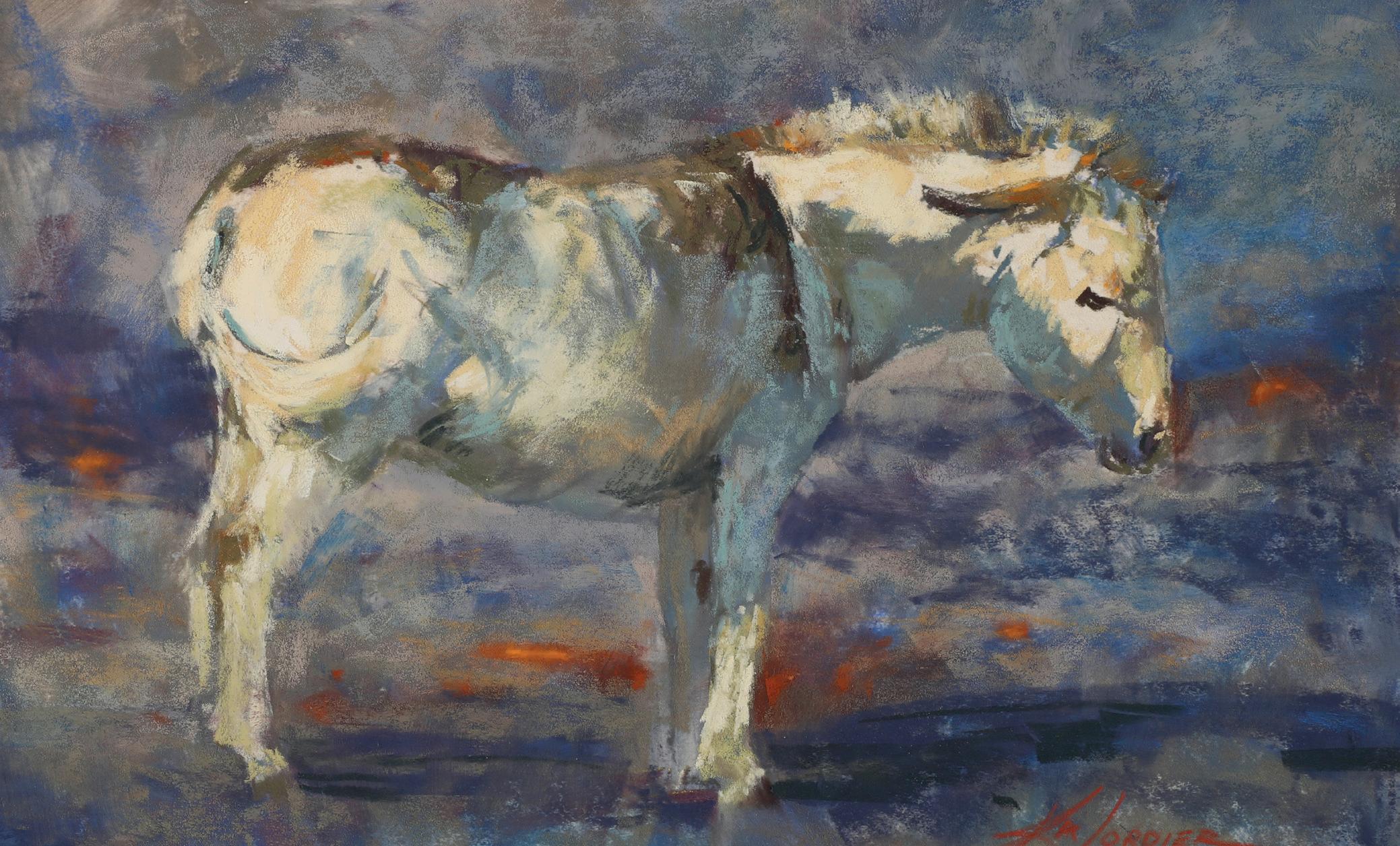
PSWC Magazine | Spring 2024 57
Our Featured Artist: Kim Lordier
Smart Ass by Kim Lordier

Kim: Well, that’s very affirming, and I appreciate that greatly because for so long I have had requests to do videos and stuff like that in a certain way that just didn’t feel right. I’ve never felt like a teacher but when I rephrase it in my head like that … I had the privilege of listening to Richard McKinley do a demo and talk and I thought, “Holy moly! I will never, ever be able to offer that much information!” Much like my mentor and friend, Skip – they have a gift and so much technical knowledge, and I felt bad that I wasn’t offering enough. But I realized that we all, as human beings, have an opportunity to lift-up and help others move forward. And I’m finding that I’m capable of doing that.
What we do, in the creative world, is share ideas. But the true growth and learning must come from within, from an individual’s commitment to their own journey. So, I am just a conduit of ideas, maybe a way for somebody to add a tool to their creative toolbox. My workshops are exercise and foundational specific, with a curriculum, but I teach and share my personal strengths and do not pretend to know everything. I am still learning.
Pam: Painting en plein air can be intimidating for
many artists. There is so much happening in every scenario. How do you tackle composition? Do you do that when choosing the focus of your studies in the field, or afterward back in the studio?
Kim: In terms of being intimidated by plein air painting, Eric Rhodes did a fabulous interview with an artist by the name of Don Demers, who is one of the most amazing marine painters living today. His interview speaks to the importance of working from life and that it is just a conversation between you, what you are viewing, and your canvas. It’s important to shut off all that stuff going on in our heads, for example, when you are at a plein air scene and there are tons of people around you judging and making comments. Firsthand observation is the key for us landscape people. So, give yourself some grace.
What I learned in terms of composition, was that to see the design, I had to focus on basic shapes. I took a workshop with Barry John Raybould and learned about the Notan process a long time ago. I filled sketchbooks with Notans of the artwork by my favorite artists from the past. It’s a good way to start practicing seeing how others have composed their works when you compress the values down, and
58 www.pswc.ws
On the Threshold by Kim Lordier
Our Featured Artist: Kim Lordier
you also realize that just because an object exists in a scene, it doesn’t mean it has to be in your painting. I don’t enjoy drawing thumbnails, but I started seeing the poster or puzzle pieces, and that was a great connection for me. I also suggest that instead of painting the whole entire scene, you creep up on it to focus on something a bit more intimate. You are gathering information like, what color and value is the grass here in sunlight compared to the color and value you are seeing with the grass in shadow?
At first, don’t try to paint the tree, and the grass, and the sky, and the barn, and the wood fence, and the horse, and the clouds, and the barbed wire fence, and the clods of dirt, and the rocks! Do a simple low horizon line and notice how it cools and darkens as it goes up. We read it in the books, but actually experiencing it, you start to see the influences of gray sky versus a sunny day and so much more.
I don’t use a viewfinder anymore, but I will sometimes
use my camera, not for the details, but to see the bigger shapes like one might with a viewfinder. If you don’t go outside to paint from life, it’s easy to get caught up in painting the photograph. You forget that you can move a rock shape or redesign the shape of the rock so it helps lead into your painting, or you can add a path or take a path away. All you need is a little differentiation in the grasses that are on the ground plane to create that illusion of moving back in space.
Pam: What is the biggest challenge you have had to overcome as an artist?
Kim: Lack of self-confidence. I used to think it was because I was a girl working in an alternative medium from oil, but I realized quickly that those were both benefits, not challenges. I believe strongly that both things got me in front of shows/organizations and galleries that were looking to be more diverse at the time.

PSWC Magazine | Spring 2024 59
Reaching the Minarets by Kim Lordier
Our Featured Artist: Kim Lordier

Pam: What is the best advice you ever received?
Kim: Jean Stern, Director Emeritus of The Irvine Museum, has been a supporter of my work from the very beginning of my journey, and said something to me early on when I was lamenting about wanting to be closer to the art hub and the organizations that were in southern California. I was in that eager, driven phase where we want everything all at once.
He said, “Kim, don’t be in a hurry for what you think you want. You will quickly become entrenched in the cycle of production and politics and will lose precious time for exploration.” He was right. As a mid-career artist, I have found myself “stuck” in a few things and not making time to explore more.
You didn’t ask, but the best advice I ever gave myself was to take the preciousness out of what I do, and
60 www.pswc.ws
Three Dog Night by Kim Lordier
Our Featured Artist: Kim Lordier
instead to think that every time I step up to the easel is a learning experience first and foremost. This mind set helps to take the internal pressure off, and allows me to get into the process or Zen of painting more quickly. There is always another canvas to start.
I think this is something that beginners, especially, have a hard time with. I still struggle with it at times. If I have something going on that has some good bones to it, I get a little nervous and then I know I need to step away and just let it go. I start something new and then come back at it with a different mindset. I think that’s another important part of the process. When you’re painting and you get in that kind of Zen mode, where the world goes away – as soon as you pop out of that, it’s time to step away from your painting. Because 9.9 times out of 10, as soon as our brain shifts to our left brain, and we continue painting, our marks are no longer painterly. Those marks never seem to relate to the whole in the same way.
Pam: You contributed to the book Beautiful Landscape Painting Outdoors by Michael Chesley Johnson, published in 2022, when should we expect to see you publish your own book? You have some wonderful blog posts.
Kim: The reason I started the blog is because I’m friends with curator and artist mentor, Rose Fredrick, who writes a beautiful blog herself. She’s an amazing woman and I was a Guinea pig for her for a while. She teaches artists how to better their business, how to speak to collectors (which I don’t do very well), and how to build up a website. She’s put together a couple of classes, and I participated in her blog writing workshop. I have written about my works for my dealer in Carmel. I can’t call it poetry, but I’ve written about the paintings and the inspiration behind the pieces.
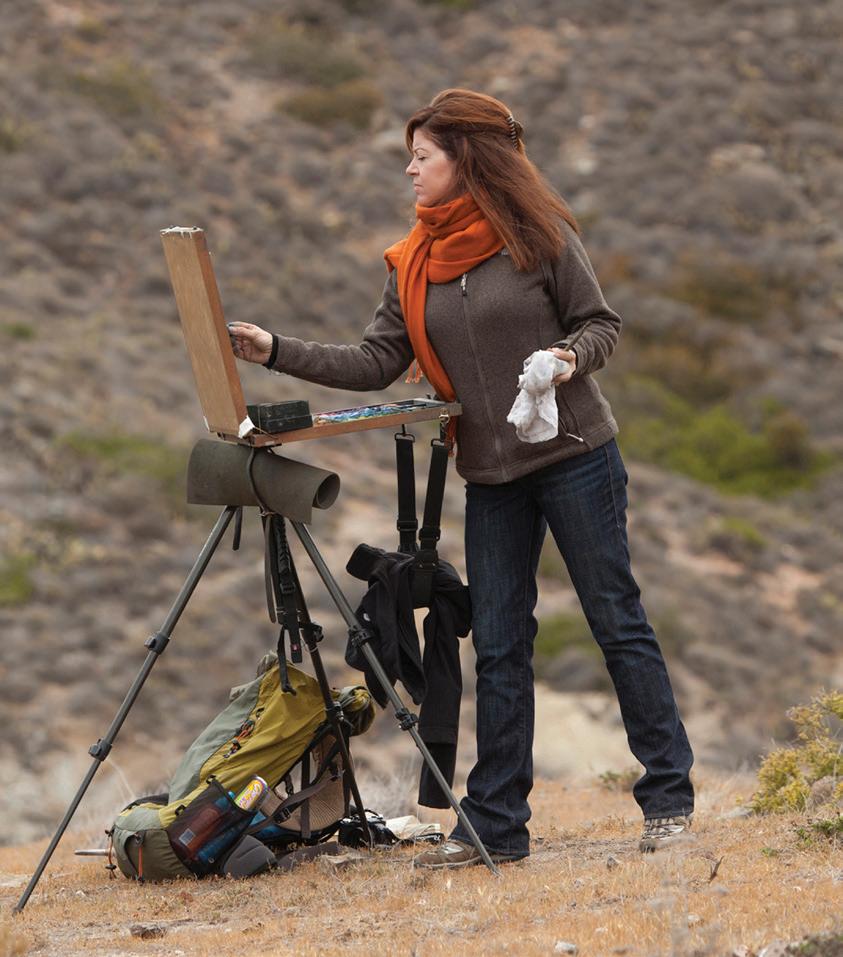
Sometimes we run across a painting that kind of paints itself, when you just know it works, but that doesn’t happen all the time for anyone. Also, I’ve had a couple of times in my journey where I’ve just felt like my work was terrible, but I must push that inner dialogue out of the way. It’s like trying to perfect a golf swing, for those who love to golf. You’re never going to have a perfect swing, and you’re never going to have a perfect painting, so we better enjoy the process because that is why we do what we do.
Pam: What advice would you give your 20-year-old self?
Kim: Keep your head up and don’t worry about what others think. Work harder, and take the precious time spent in the illustration department seriously. I wasted time back then.
You know, I kind of have been dreaming about creating a book, but less a “how-to” and more of a reflection of my work and writing about it. I love to write small stories about the spark of inspiration, or the place, or something that made painting a particular scene/place special to me. I get asked a lot about when I am going to do a video, as well. Sometimes I think I should, then other times it scares the shlitz out of me, having something that permanent out there when I am clearly still learning to get better in my own craft. I don’t know exactly what it would look like, but a book would be fun.
Pam: There you have it, folks … keep an eye out for the upcoming book by Kim Lordier! Any final thoughts?
Kim: Oh, dear! Just, thank you very much for this opportunity. I’m grateful. That’s my final thought.
www.kimlordier.com
PSWC Magazine | Spring 2024 61
Kim Lordier on Catalina Island
Our Featured Artist: Kim Lordier
 Golden Bouquet by Tamsen Taves
Golden Bouquet by Tamsen Taves
Editors note: Tamsen Taves is the youngest member of the PSWC. She is an immensely talented artist currently attending Fresno State and working in her family’s Car Wash business.
Tamsen has studied with Daniel Keyes and painted with LaVone Sterling (Signature member of PSWC)and Ginny Burdick (former owner of A Sense of Place Gallery and a noted artist as well). She has absorbed this trifecta of artist brilliance and attained an impressive level of artist and social maturity. She speaks with a confidence that supports her talented work in both oil and pastel.
This is an artist that we will enjoy watching as her career takes off!
PSWC Mag: When did you know you were an artist?
TT: There wasn’t a specific moment where I knew I was an artist. I was considered artistic ever since I was young. It took me until 2021, when I was 19, to seriously consider art for a career because I wasn’t sure if it would be possible to become an artist fulltime. At about that time, I started oil painting with the local artists at A Sense of Place Gallery where I was encouraged to try pastels.
PSWC Mag: What motivates you to make art?
TT: I love to improve myself in whatever I do. Painting accurately is a great challenge and each time I get to paint, it gives me an opportunity to learn something new. I enjoy getting the time to appreciate what’s around me whether it’s a beautiful bouquet or a coastal sunset. When painting from life, it gives the unique opportunity to explore all of the intricacies of my subject matter. In addition, it is a great joy for me to share beautiful things with others.
Tamsen Taves
by Tamsen Taves with Sabrina Hill

PSWC Mag: What is your creative process?
TT: Whenever I start a painting, I begin with a specific goal in mind. For instance, I might place an extra emphasis on color, value, edges, composition, texture, or a combination of the list. This keeps me focused, builds muscle memory, and from becoming completely overwhelmed by my task ahead of me. Before I start, I will paint the scene in my head to plan out my steps, while leaving some room for spontaneity. Through this technique, I can find places in my composition that might need adjustment, or spots that I need to be particularly careful. For pastels I have been using a 400-grit surface and start by loosely blocking-in the basic colors and values of the painting. Next, I apply an alcohol wash across the entire surface. This step
PSWC Magazine | Spring 2024 63 Meet the Member: Tamsen Taves
Artist Tamsen Taves
Meet the Member: Tamsen Taves

seems to add a more painterly quality to my work. After it dries, I layer more pastel and refine. Though, all of my techniques or materials may be subject to change overtime as I like to experiment with different ideas.
PSWC Mag: How do you overcome creative blocks?
TT: I haven’t yet experienced any significant creative block yet (fingers crossed!). I like to have a lot of paintings planned out in my head. If I do feel stuck on something, I usually need to take a very intentional break from painting for a day or two. Spending time at a garden nursery can be pretty helpful for refreshing my mind too! These things tend to put me back on track and brimming with ideas. I use both oils and pastels and switching between mediums helps me stay focused as well.
PSWC Mag: Do you do research for your paintings?
TT: Yes, that is very important to me, but I don’t always research consciously. For example, I might be reading a book that contains a description that
interests me, or scrolling online and see a fabric pattern which eventually inspires an idea for a still life. I try to write down any of these types of things that catch my eye because I never know what might strike me as inspiration later on. I am constantly looking at what’s around me to get new painting ideas whether it’s a particular lighting in the sky or patterns of color. I have thousands of photos taken for references on my phone, which occasionally comes in handy. When I am researching online or looking at other people’s work, I try to analyze why I like certain aspects of their art. For example, I try to break down what makes someone’s brushstroke effective, or why a certain pattern of light works on a painting.
PSWC Mag: What artistic challenges do you face?
TT: I put a lot of pressure on myself when I paint and can be quite hard on myself if something isn’t turning out exactly how I envisioned in my head. I often struggle finding time in my day to paint as I’m a full-time student and work part-time as an office
64 www.pswc.ws
Luminous Sunset by Tamsen Taves
 Backlit Blossoms by Tamsen Taves
Backlit Blossoms by Tamsen Taves
Meet
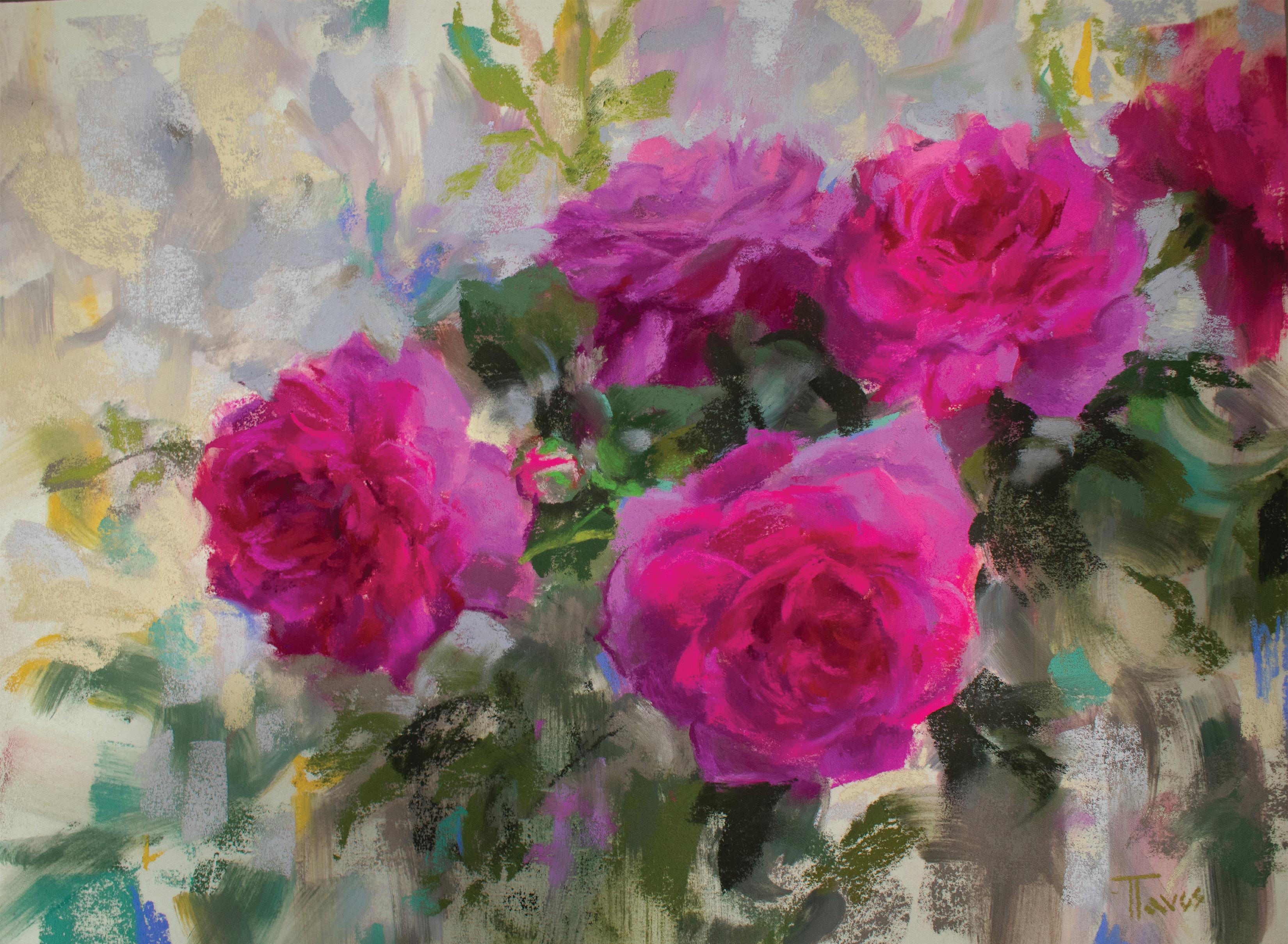
assistant for my family’s small business. I’m usually working on my paintings in the late hours of night.
PSWC Mag: How do you maintain focus when working on long-term projects?
TT: I am usually working on multiple paintings at once. If I am working on a large piece and am need of a break, I often will complete a few small pieces to help give me a fresh perspective and reinvigorate my interest in the lengthier paintings.
PSWC Mag: How do you handle criticism?
TT: I think criticism can be of great value. Criticism is a way for me to grow and improve my paintings at a faster rate. I think it’s extremely helpful to see something from someone else’s point of view, while also keeping perspective of what’s feasible and what
direction I think my art should go.
PSWC Mag: Do you have a favorite subject or theme in your art?
TT: I like to work with a wide range of subject matter. At the moment, I greatly enjoy painting flowers and seascapes. It’s nice to have a change in pace when I receive portrait commissions too.
PSWC Mag: What’s your favorite painting of your own?
TT: I’m always looking towards my next painting. I do get excited when I feel I have reached a breakthrough in a painting. That tends to add a specialness to me. On average, some of my favorite paintings tend to be my larger pieces.
66 www.pswc.ws
the Member: Tamsen Taves
Magenta Melody by Tamsen Taves
PSWC Mag: What is your philosophy on framing? What technique do you use?
TT: I purchase my frames from a various sources and always try to maintain a high standard of quality. For my process, I start with using a fixative on my pastel painting to minimize any movement of pigment. Next, I frame my pastels with museum glass put archival tape on all of the sides of the piece.
PSWC Mag: Do you use apps to organize your art and sales?
TT: I use a website that allows me to send out newsletters and organize sales (tamsentaves.com). Through my social media I often show new works and try to keep my followers updated through my Instagram page (@tamsentaves). I use Microsoft Excel to organize some of my data as well. For graphics and images of my artwork, I use various Adobe programs such as Lightroom and Photoshop.
PSWC Mag: What role does social media play in the development of your art career?
TT: I have been experimenting with social media over the past couple of years to promote my brand and artwork. It does play a big role in making sales and giving people a way to easily find and view my work. It’s a nice way to stay in touch with collectors and educate followers about pastels as well. I’m currently taking a social media marketing course at my university, so I have already started to implement new ideas from this class to my Instagram page.
PSWC Mag: What are your long-term art goals? How will you achieve them?
TT: I have many ambitious goals for my art. I hope to eventually become a full-time artist as I am still a college student. To achieve this, I plan to work fervently with careful steps to build my business. Another goal is to improve my artistic abilities. I have a lot of room for growth, and it excites me to whenever I learn something new while painting. To accomplish that, I need to get more “brush mileage” and be very intentional every time I work to maximize my time spent painting.
PSWC Mag: What steps do you take to promote your work and brand?
TT: I think understanding the business side of art is
Meet the Member: Tamsen Taves
extremely important, as an artist must be essentially an entrepreneur. I am a business major expecting to graduate this spring with an emphasis in marketing and minoring in fine art. I plan to use this knowledge to promote my work and brand.
PSWC Mag: What advice would you give your 20-yearold self?
TT: Funnily enough, that was only two years ago, so it’s a bit too early for me to tell what advice I would give.


PSWC Magazine | Spring 2024 67
Aspen Grove by Tamsen Taves
Tamsen Taves, En Plein Air
Art Ethics
Inspiration or Infringement: Is Someone Stealing My Work?
by Laura Pollak, PSA, PSWC, PSNC, PPS, SPS, IAPS MC
Long ago, when I had my own ad agency and was in my twenties, I was asked to do a corporate brochure. I was thrilled, as it was a big project and would bring us weeks of work. The client showed us a brochure with a style and graphics they liked and said, “We would like something like this.” Without thinking twice, I said, “Sure,” and we proceeded to set up a layout that was similar and even did photo shoots that took on that style and lighting. Months later, the client came back to me and said that the brochure we did was very well received, but the creator of the sample from another source had contacted them with a furious note that their creative style and work had been copied. It had never occurred to me that I was stealing someone else’s work. I was too naive to realize the concept of creative rights.
when we simply copy something, we replicate it without any original thought or innovation.”
I believe ‘Stealing” requires no further explanation. While I do not have all the answers, I can offer a few incidents and some hard learned advice to help us along.

This brings us to the question of inspiration versus copying versus stealing. As I was told in my advertising days, “There’s nothing new under the sun. It’s just how we recombine old things.” However, there is a difference. The blog 1605 Collective sums this up best:
“When we are inspired by something, we take an idea or concept and make it our own. We build on it, adding our own unique perspective and creativity to create something new and original. In contrast,
It Happened to Me
In 2019, a good art friend sent me an email with the question … ‘Have you seen this?’ It was a Facebook post from an artist I had not heard of before, showing a piece of work remarkably close to one of mine. I was actually flattered! Wow! Someone liked my work enough to copy it. However, when I read the caption that accompanied it, I felt uneasy. It said, “This is my foray into abstract art.” Hmmmm, what do I do with this?
At first, I thought it was harmless. Then I contacted my wonderful friend, Lyn Asselta. She said I needed to act on this immediately! The reason was that my piece was accepted into the IAPS show, and if there was any question as to who the original artist was, I could get in trouble. That was motivation enough to act. She advised me to reach out to some higherups in the Pastel world, which I did. Here are some samples of the original artwork and the clearly
68 www.pswc.ws Art Ethics
copied pieces, trying to be passed off as their own.
In the end, I contacted the artist who copied my paintings and told him I was truly flattered that he copied my works but could he please either remove the content from the Internet or give me credit/ attribution. He was contrite and gave me credit.
Fast forward to 2023. Another artist friend on Facebook sent me yet another picture from this exact same artist who had entered those same works from before into a competition. And to boot, he was the President of a pastel society! The first time I dealt with him, I did not ever publicly mention his name, this time I was angry and uncertain. What recourse did I have?
I consulted a retired attorney who asked if any monies were taken or lost. The answer was no. And while you might think, “No harm done then,” there was harm done. My work was being judged


and possibly sold under another artist’s name. So, I contacted the society where he was President and told them in unequivocal terms that he must be removed as President, and furthermore, that the works must be taken down from the show and disqualified. The person I contacted did not even acknowledge that my works were copied, even with side-by-side proof. This time I ‘outed’ him on Facebook and named him. Many people unfriended him, and eventually he stepped down as President of his Society. A couple of months later, the thief finally replied to my email to him, with a type-written letter saying that he’s sorry that I “thought he copied my artwork,” while never admitting that he did. So bottom line here is don’t go easy. Stop the incident at the first sign. Confront the perpetrator. Do not let it pass.
We have all worked so hard to create something unique to let someone with less imagination or creativity simply claim it as their own!
Laura Pollak’s
Original Paintings

...and the knock-offs (NOT done by Laura Pollak)

PSWC Magazine | Spring 2024 69 Art Ethics
Inner Fire by Laura Pollak
Emeralds by Laura Pollak
Is this Mine?
Two weeks ago, a high-level pastel artist, who knows what I’ve experienced, showed me a painting from someone else and then showed me their own painting. The similarities were clear. The copied landscape had every curve of a shoreline, cloud formation and color palette perfectly copied. My friend asked me what I thought she might do. I suggested that she kindly contact the artist of the copy and ask her to please stop posting it, and remove it from all social media.
Well, it turns out much the same happened as with my brochure story above. A collector handed the artist a picture she liked and asked for a copied commission. (Of course, without permission of the original artist.). The copying artist did not think that this might be someone else’s painting and simply (and deftly, I might add) copied the original painting. The copier was very apologetic, and honestly claimed that she did not know that it was an original from another well-known artist. She removed the piece from social media and is no longer claiming it as her own.
Hey, I’m on TV!
A very well-known pastel artist saw more than 20 of her paintings on the set of a TV Show without her permission, season after season. At first, it was dismissed, but when it was happening again and again, something had to be done. It turns out that an intermediary was offering access to prints without the permission of the actual artist. At first, the intermediary denied the distribution, but they finally admitted the infraction. After a lawsuit, and lots of wasted time, the case was settled with less than satisfactory results. There was enough of a settlement to take a nice vacation but little else. It was not enough to make up for the lost time and sleepless nights.
Fight or Flight?
A well-loved artist, who worked hard to create a wonderful style and excellent content for Patreon, had a student who pilfered all the lessons, copied the unique painting approach that was taught and started marketing themselves to great success using another artist’s lessons and style. She confronted
the copying artist; however, the accusation was denied, and a threat was made to ruin the original artist through social media as the copying artist had a much larger platform. Fighting would mean gathering years of records, documenting the theft, and suing to the tune of thousands of dollars. Many who have heard the above story were indignant and ready to fight. However, the realities of the judicial system are that it can drain you dry emotionally and financially with no guarantee of outcome.
Knowing that artistic theft is out there, you need to keep meticulous records, with timelines to be used for incriminating proof of theft. If you have that data, then you might have enough to use as a deterrent for continued infractions, and the threat of an easily winnable lawsuit.
And Now for Artificial Intelligence
In addition to circumstances like the ones outlined above, the concept of Artificial Intelligence now brings new problems to the realm of original artist and copyright ownership. AI software programs work by gathering data based on the criteria entered, searching the vastness of the Internet, and then presenting images that already exist (including your own posted artworks), prose, music, and so on based on these searches, to come back to you with a composite. If pieces of our works and kernels of our concepts are used, then is it theft? It might be. The use of artificial intelligence is in it’s infancy, but the more art you put on the Internet, whether on your website, on Facebook, Instagram, TikTok, Patreon, YouTube, and so on, the great possibility that your images will be swept up in a data collection search for “sunflowers on a yellow table” or “boats in the harbor.”
How To Protect Yourself
So, let’s discuss the concepts of creative selfdefense. (I like to call it Defense Against the Dark Arts, a la Harry Potter) How can we protect our unique works from the poaching of others, whether an innocent likeness or a blatant copy?
Know your original inspiration or image. Always use your own references. Be wary of commission requests where the client is supplying an image off the Internet or based on another artwork.
70 www.pswc.ws
Art Ethics
Become copyrighted. Register your works (perhaps as a bundle) with the Library of Congress. There are costs associated with the copyright, but if you are earning a living as an artist, whether full-time or occasionally, this may be worth it. Go to copyright. gov and you can submit works as a bundle.
Record keeping is a must. Keep good records of the creation dates of your own works. If you can afford to, register your works with a legal entity, and if you see something where you are indeed being pilfered from, confront the perpetrator as soon as possible. Assume the best, and be prepared for the worst.
Quora/Bookalooza offers this advice:
Discovering that someone has published your work without permission and is profiting from it can be a distressing experience. However, there are actionable steps you can take to address this infringement and protect your rights as a content creator. This guide outlines the recommended actions to navigate such situations effectively.
1. Confirm the Infringement:
a. Gather Evidence:
- Collect proof of your original work, including timestamps, drafts, or any other documentation that verifies your authorship.
b. Identify Infringing Material:
- Clearly identify the portions of your work that have been used without permission, noting specific instances of infringement.
2. Contact the Offender:
a. Send a Cease and Desist Letter:
- Draft a formal cease and desist letter demanding the immediate cessation of unauthorized use, removal of the content, and disclosure of profits made.
b. Provide Evidence:
- Attach the evidence of your authorship and the infringement to the cease and desist letter for clarity and emphasis.
3. Explore Copyright Protections:
a. Register Your Work:
- If your work is not already registered, consider registering it with the relevant copyright office to strengthen your legal position.
b. Understand Fair Use:
- Assess whether the use of your work falls under fair use or if it constitutes copyright infringement. Seek legal advice to interpret fair use nuances.
4. File a DMCA Takedown Notice:
a. Submit to Hosting Platforms:
- If the infringing material is hosted on websites, submit a Digital Millennium Copyright Act (DMCA) takedown notice to the hosting platforms.
Know when to hold ‘em and know when to fold ‘em. Sometimes it is worth the fight to retain copyrights over your work. And sometimes you must let it go, with the caveat that you will be on top of your record-keeping as you move forward. We have worked too hard to let it pass. Be vigilant against the Dark Arts!
I hope I have presented a few scenarios which will activate your radar and keep you on the look-out for potential problems. Above all, keep painting!
b. Follow Platform-Specific Procedures:
- Adhere to each platform’s specific procedures for filing a DMCA takedown, providing all required information and documentation.
5. Legal Action:
a. Consult an Attorney:
- Seek legal advice to evaluate the viability of legal action. An attorney can guide you on potential legal remedies and assist in drafting a formal legal complaint.
b. Small Claims Court:
- In some jurisdictions, consider pursuing resolution through small claims court, which may offer a quicker and more accessible legal process.
6. Document Financial Loss:
a. Quantify Damages:
- Document and quantify any financial losses incurred as a result of the unauthorized publication, including lost sales or potential earnings.
b. Include in Legal Proceedings:
- If legal action is pursued, present the documented financial losses as part of your case.
7. Monitor and Enforce:
a. Regularly Check for Compliance:
- Regularly monitor the internet for compliance with your requests and take further action if the unauthorized use persists.
b. Stay Informed on Legal Developments:
- Stay informed about changes in copyright laws and regulations that may impact your case or rights.
Conclusion:
Dealing with unauthorized publication and profiting from your work requires a strategic and systematic approach. By following these steps, you can assert your rights as a content creator, protect your intellectual property, and take appropriate actions to address the infringement. Remember to seek legal advice to ensure that your course of action aligns with the laws and regulations in your jurisdiction.
PSWC Magazine | Spring 2024 71 Art Ethics

Art School
Having Fun with Texture
— The Cottonwood Refuge Pastel Painting
by Dug Waggoner
72 www.pswc.ws Art School
A driving tour with friends leads to inspiration at the Sacramento National Wildlife Refuge
On a northern California driving tour with friends, one of our group found an area called the Sacramento National Wildlife Refuge located near Williams, California. At that time of year, the spring runoff filled the ponds and tule reed landscape with water.
This natural refuge is a flyby for migrating birds and the water and sky can be filled with thousands of song and waterbirds. Reference photos showed atmosphere, reflections, shadows, mood and drama and later gave my experiments with surface texture a chance to continue to evolve in the direction I desired.
Working from photos in the studio can’t compare with the immediate information that plein air observation can give the artist. Holding a printed copy of the chosen photo can never replace the fresh air atmosphere that plein air and mother nature can teach you. Having said that, I make mental notes about what I felt at the moment the photo was taken. Many of the reference photos I took that day brought out emotions, and a number of them provided good design and a sense-of-place narrative as well.
About my prepared surface
My latest painting substrate is gatorboard but with added texture. The Gatorboard surface on its own is not the surface I prefer to paint on so I’ve come up with a prepared mixture of Golden Acrylic Ground for Pastel, gesso and an acrylic color of a warm mauve tone in a number

Back in the studio I open up Photoshop on my computer and view several of the photo images that have potential and size them to match the proportions of my final painting size. I then mix and match and edit shapes until I have the desired image for the final painting. I print two scaled images as reference. One in full color and another in black white with quartered grid lines to scale up to the full size of the painting. These prints orchestrate design for the finished piece. In all these steps the song is the same but I can improvise over this textured surface to find it’s final voice.
Turn the page for a step-by-step of my process.
4 value. I apply this mixture to the Gatorboard with an old, wellused, 2” brush. The trick is to make brush strokes that create texture that follows or gives movement to shapes, creating subtle ridges that enhance the entire painting. When those ridges in the brush strokes are dry it adds a wonderful
dance to the image. Cross hatching the brushstrokes only adds confusion to the texture. Another trick in the process is to tap lightly with the flat side of the brush in the areas you want the feeling of leaves and such.
PSWC Magazine | Spring 2024 73 Art School
School
Art

1. I grid off the painting surface and block in the biggest shapes with NuPastel. I’m conscious of the design as I add alcohol to melt the NuPastel and play with pushing things back and forth.

3. I’m adding the blue colors over the top of the pinks. I love the playful tension and vibration between the two colors when the pink shows through the blues. This step shows me the contrasts between the darks and lights, warms and cools.

2. Now working in the sky area I want to set up the bottom layer with a pink, contrasting color behind the blues that will eventually occupy the area. I add some alcohol to set it into the surface. I spray the pink with my favorite fixative, SpectraFix, to hold it in place.

4. Now I’m beginning to add more of the surrounding colors, working them in and around the piece. Always being mindful of the original printed image for color notes but at the same time looking for ways to break away from the original. The original photo is a guide, not the master.
Of course, there were many changes, and often compromises, from the original photo but that is why we are the conductors of the painting. We are not slaves to the photo. There is also a point in the process when the painting starts to speak to me and it’s usually right.
As part of the final process, I make a “frame” with black tape. This shows me how the design and composition are working as the image meets the inside edge of the black “frame”.
The painting, “Cottonwood Refuge” was a success in that it won a first place in the 2023 Pastels USA/99 Voices In Pastel Show. As a final nod to its success, the painting was included in a group show of winners from that show and was displayed at the Hilbert Museum of California Art on the campus of Chapman University, in Orange, California
The final painting is at right.
“Cottonwood Refuge,” soft pastel, 19.5” x 15.5”.
Art School 74 www.pswc.ws

Art Workshop
Judith Leeds

So often, portraits, especially those commissioned, are stiff and don’t reflect the personality of the subject.
In my workshop, you will learn how to find the unique qualities of each model, not just of the head but also the whole figure. I’ll instruct you on how to pose and light the model to best reflect their feelings and personality.
Some of the subjects I will cover are pastel techniques, composition, the effects of light on the face and clothing and how to integrate the background with the figure. Each day I will do a demo to illustrate what we will be covering that day.
Capturing the person behind the pose
TBD 2024

Judith Kazdym Leeds is a internationally known award winning artist who has created over 3,000 book jackets including the classic book, THE COLOR PURPLE. Her work has appeared in both national and international magazines and has won numerous prestigious awards and medals. She was named by PRINT Magazine, in its 40 year Design Retrospective, as being among the elite group of artists who had created the most innovative designs in the United States over a forty year period.
Judith paints portraits, still-lifes and landscapes in both pastels and oils. Her work has garnered many awards, medals and honors
https://www.judithleeds.com
76 www.pswc.ws
Art Workshops
Art Workshop
Dawn Emerson
New Approaches since Pastel Innovations!
April 27-28, 2024
DAILY SCHEDULE:
10AM-12 Noon, 12-2 Lunch break, 2:00PM-4:00PM

Dawn will present new techniques that she’s discovered since her book was published in 2017. The following topics will be covered: *PanPastels and the PanPastel MEDIUMS- what they are and how to use them *New additive and subtractive layering approaches with PanPastel and stick pastel with mixed media – a whole new approach to painting that is more like sculpture or intaglio printmaking!
Dawn’s approach is to do short demos (5-15 min) followed by time at the easel for each student to do the same. She will be teaching alternative approaches that hopefully will inspire creativity for all levels of experience. She will ask students to explore what they learned between the first and second class.
About Dawn (from her website): I began printmaking in 2008, and that led to incorporating mixed media in my work. Sharing those discoveries became the basis for my book “Pastel Innovations,” which was published 2017 and is now printed in 4 languages. I’ve had 6 instructional dvds produced, and made a new video available on Vimeo titled “Breaking New Ground” that features new techniques about layering pastel with water mixable oil. My studio is my “Innovation Laboratory,” and I hope to inspire you to dance with your easel, play, and enjoy!

https://dawnemerson.com
PSWC Magazine | Spring 2024 77 Art Workshops
Art Workshop
Mark Ivan Cole

Goal: New approaches and techniques for communicating our emotional response to the landscape.
Content: In this workshop we’ll explore a variety of different tools, applications and methods for using pastels to paint emotionally accurate landscapes. We’ll talk about reference selection, photo processing and compositional choices. Mark will demonstrate different approaches to creating painterly images, from block-in to finishing details, including how to set up a dry underpainting and how to suggest details. Participants will have the opportunity to use these techniques on their own paintings and receive direct feedback.
Approach: Mark is a hands-on demonstrator who fields questions even as he paints. Workshop participants can watch and/or paint along as he does the demonstration. Depending on the workshop size and student preferences, we can do breakout sessions with individuals or do critiques and discussions with
Going for “Feel”: Emotional Landscapes in Soft Pastels
August 24-25, 2024
the whole group involved.

Zoom is the main tool, and Padlet is used as a simple bulletin board where participants can post reference options and work in progress, and comment on the posts of others (much like Facebook).The raw video is recorded and will be made available at no cost on YouTube for participants for one month after the workshop. The Padlet board will also be live for a week following the workshop. Participants can post their work and solicit feedback. Mark will respond to all posts during that week.
https://www.markivancole.com
78 www.pswc.ws
Art Workshops
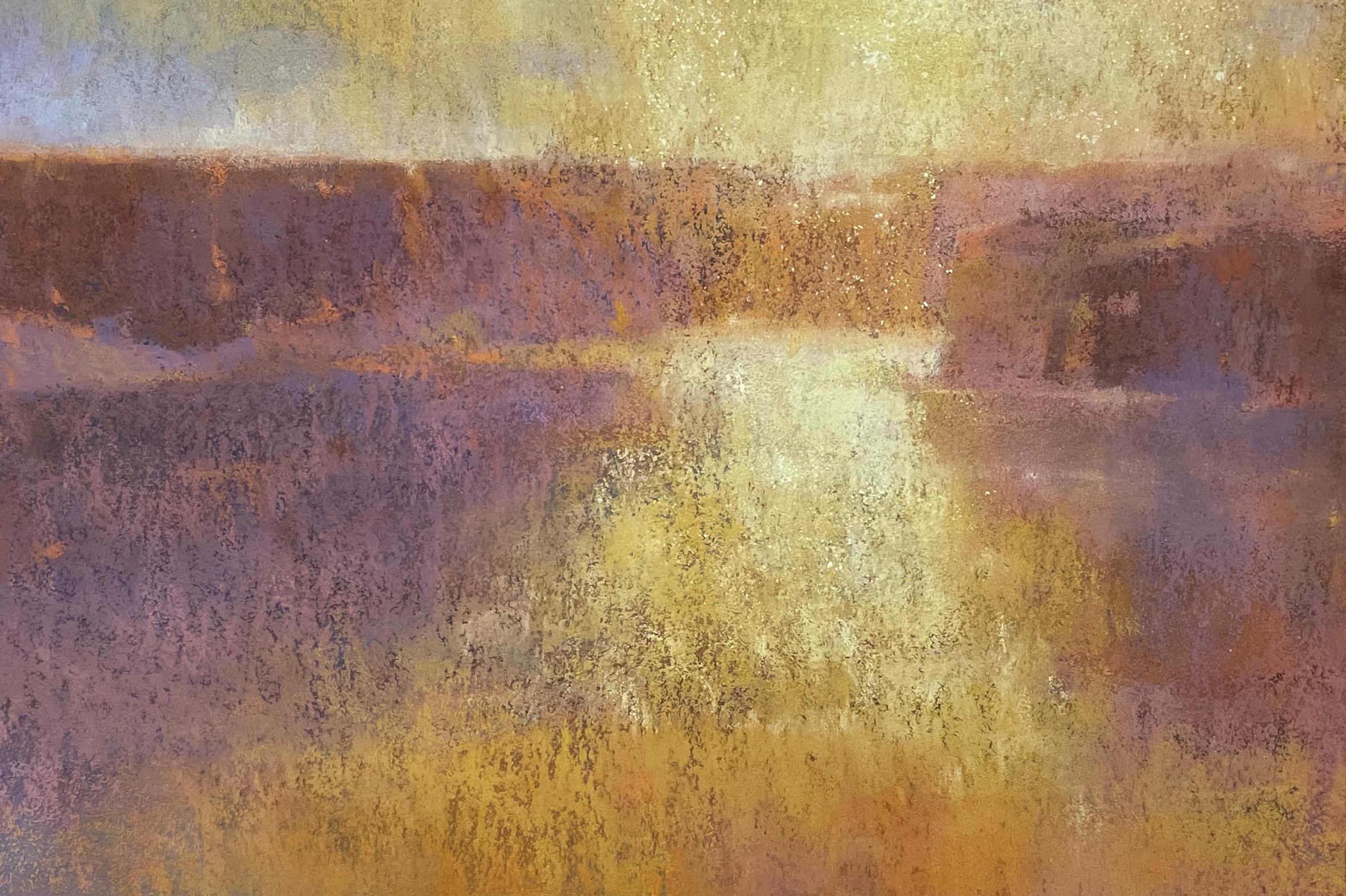

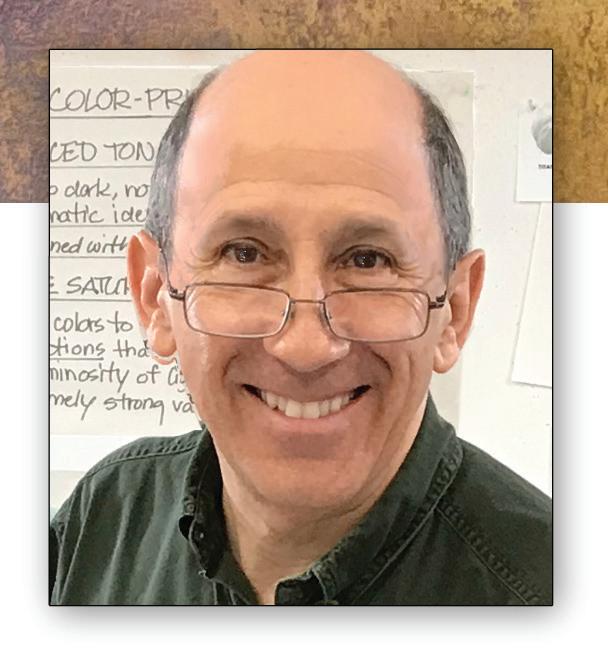
THELANDSCAPEPAINTER'SWORKBOOK: EssentialStudiesinShape,Composition, andColor
“ThisbookencapsulateseverythingIwantto getacrosstomystudentswhenIdoa workshop...Thisbookexplainseverything.” –
CharlieHunter
LANDSCAPEPAINTING:
EssentialConceptsandTechniques forPleinAirandStudioPractice
“AbsolutelythefinestbookI’veeverreadon landscapepainting!ThatlistincludesPayne, Loomis,CarlsonandHarrison.Yoursisbetter thanallofthem.” –DonDemers


LANDSCAPEPAINTINGBOOKSCOMPARED:
PSWC Magazine | Spring 2024 79
Thebestsellingbookon landscapeatAmazon
A“newclassicoflandscape” forover14years
MitchellAlbala, PSA
mitchalbala.com/books-compared/ Landscapepainting,workshops, books,paintingblog,andmore Discoverandlearnat mitchalbala.com Impression,DryFalls, pastelonpaper


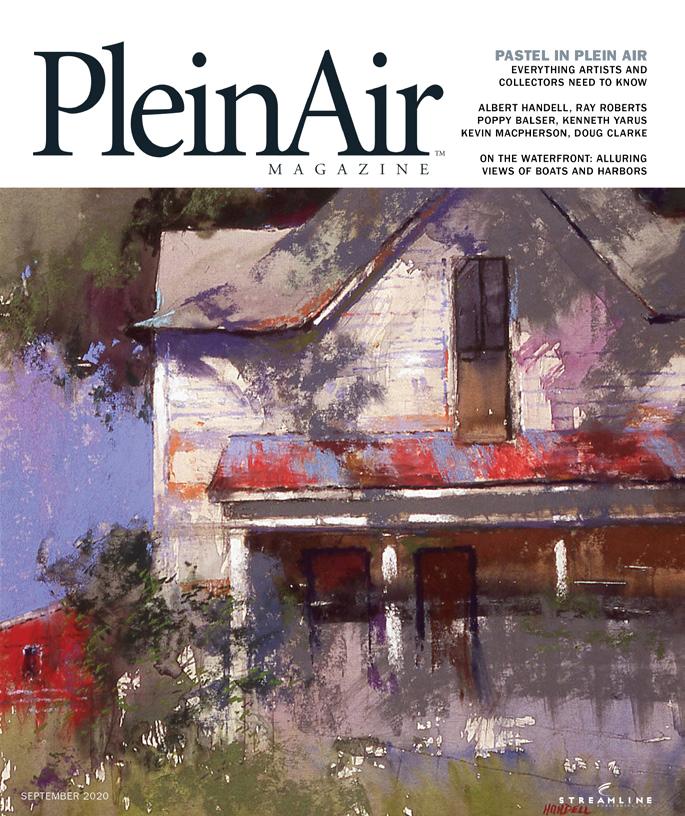
Subscribe today | 800.610.5771 | pleinairmagazine.com The Old Family House in Lipscomb, Alber t Handell, 20 02, pastel, 18 x 17 in , Private collection, Plein air, Cover September/October 2020 Issue The cure for claustrophobia. proud sponsor of the Pastel Society of the West Coast
PSWC HOUSEKEEPING
EXHIBITION NEWS
Pastels USA: 99 Voices in Pastel is being held at the Brea Gallery in Brea, California.


The Brea Gallery is a 6,500 square foot contemporary art space that presents four major exhibitions per year. Located in the Brea Civic and Cultural Center, the Gallery has been offering meaningful exhibitions, workshops for all ages, artist lectures, live art demonstrations, a gift shop, and unique artistic opportunities for the community since it opened in 1980.
The Brea Gallery is a community-based arts space, working with upcoming and established artists in a variety of ways. However, the Gallery does not represent artists, have a permanent collection, or offer art appraisals. Please visit our opportunities page for information on how you can be a part of what we do here.
ART SCHOLARSHIPS
We offer Art scholarships to college students who are planning to major in art. The criteria is posted on the website. Deadline is in just a few weeks, so if you know an art student, have them apply online by April 15, 2024.
MEMBERSHIP DRIVE
One of the best ways to support a healthy society is to bring in new members. There are lots of good reasons to join. If you have artist-friends who are not members, now’s the time to invite them to join. Contact Karen Jones, if you have questions or would like more information.
WORKSHOPS
If you are looking for a workshop to take or are a pastel teacher looking to teach a workshop, contact us! Jean Myers is our workshop coordinator, and she is awesome. We are currently offering in-person and ZOOM classes with some of the best pastel teachers on the planet.
82 www.pswc.ws
Housekeeping
NEW MEMBERS -January to March 2024


EXECUTIVE BOARD
President/Regional Reps/ Scholarship
Pamela Comfort e: pam@pamelacomfort.com
Interim Vice President/Magazine
Sabrina Hill e: art@sabrinahill.com
Secretary
Bonnie Griffith e: bzgriff53@gmail.com
Treasurer
Deborah Pepin e: deb.treas.pswc@gmail.com
BOARD APPOINTEES
Membership Chair
Karen Jones e: pswcmembership@gmail.com
Pastels USA 99 Voices Co-Chairpersons
Francesca Droll e: fd@abacusgraphics.com
Peggy Davidson Post e: peggydpost@gmail.com
Membership Show (MOOS) Chair
Dug Waggoner e: dugwaggoner@att.net
Ways & Means Chair Open Workshops Chair
Jean Vineyard Myers e: jeanmyers1990@gmail.com
Publicity Committee Chair Open
COMMITTEE MEMBERS
Website Coordinator
Diane Breuer e: diane@dianebreuer.com
Membership Status Chair
Jan Miller e: halfhalt@saber.net
Social Media Coordinator
Unfilled eBlast Coordinator
Cynthia Riordan e: clriordan@gmail.com
PSWC Magazine | Spring 2024 83 Housekeeping
Kiss by Cindy Gillett


We. Are. Pastelists. Join us and find out what it’s all about. www.pswc.ws
Karen Miller in the Mustard Fields

































































































































































































 Big Sur Glory by Kim Lordier
Big Sur Glory by Kim Lordier











 Golden Bouquet by Tamsen Taves
Golden Bouquet by Tamsen Taves


 Backlit Blossoms by Tamsen Taves
Backlit Blossoms by Tamsen Taves

































